How to write the perfect design dissertation
Tutors and students from top design colleges share their advice.
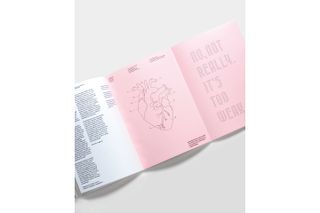
Studying design is about crafting a great design portfolio that will wow potential employers, right? Well, yes. But don't discount the importance of astute creative thinking, and expressing yourself eloquently through the written word. In short, your design dissertation matters.
"I don't believe that design students should be focused entirely on portfolio work," argues Myrna MacLeod , programme leader for Graphic Design at Edinburgh Napier University. "They should also be able to demonstrate an interest in the contexts that underpin their work, and the histories and connections that have informed our practice."
- 5 top tips for graduate designers
"Think of a dissertation as an opportunity, not a burden," urges Craig Burston , Graphic and Media Design course leader at London College of Communication (LCC). "It gives us visually-minded people an opportunity to demonstrate that we too can construct arguments and distil complex notions."
As Burston points out, this is not just an academic exercise: the power of persuasion is often key to success as a commercial designer. "Clients seek clarity, and project concepts or proposals need to be put into context," he says.
Read on to discover some top tips from leading tutors and their students for nailing your design dissertation…

01. Treat it like a design brief
"A great dissertation should be a designed artefact, and portfolio-worthy in its own right," says Burston. And like a design brief, it should be about solving a problem: "Make sure it has clearly stated aims, strong focus, and doesn't lack opinion or rhetoric," he adds.
- Best laptops for graphic design
"The value of a designed dissertation as a portfolio piece is that it's a holistic view of the individual," agrees Sarah James , senior lecturer in Visual Communication at Arts University Bournemouth (AUB).
"It shows, type, editorial, research and aesthetic skill, as well as the personal interests and convictions of the individual."
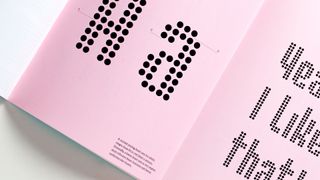
James identifies AUB student Maarit Koobas , who investigated responsive type in both her dissertation and final project, as a particularly strong example of this. "Her design version was one of the most authentic, restrained and elegantly expressive I have ever received," she enthuses.
Koobas conducted a huge amount of initial research into both the contexts in which responsive type can be seen – such as advertising, product design, science and material cultures – and the theories behind its analysis, including semiotics, philosophy and politics. "Creating and analysing ideas, before they end up in your portfolio, is what design is all about," argues Koobas.
- 5 must-read books for design students
02. Write about your passion
"To develop essay questions, AUB students are asked to consider what they love, hate or are puzzled by in their practice – essentially, what moves them," says James.
"A poor dissertation is inauthentically chosen for ease as opposed to interest," she adds. "It rambles and blusters, using complex language to mask insufficient research."
"You can tell a mile off when the writer isn't interested," agrees Burston. "How can you expect the reader to care about it if you don't? Write about something that reflects your interests, focus and direction. I've read fascinating dissertations on topics as diverse as patterns in nature, and Brutalist car parks. Make me interested in what interests you."
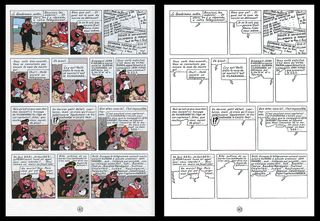
For Edinburgh Napier graduate Fiona Winchester , this topic turned out to be typography in graphic novels. "I love reading them, but I think people still don't take them seriously as an art form, which is a shame," she says. For her dissertation, she conducted qualitative interviews using modified pages with and without imagery (shown above).
Her advice is simple: "Narrow down your idea to be as precise as possible. The smaller your question, the easier it is to research and try to answer it."
If you're struggling to get the ball rolling on the actual writing process, Winchester advocates starting with whichever bit you have ideas for. "If you're stuck, it's so much easier to write in whatever order it comes to you, and then edit it into a dissertation, than to try write straight through from beginning to end," she insists.
03. Don't be afraid to talk to people
"I always think my students get the most out of the new streams of knowledge they find from talking to people," says McLeod. "It breaks down barriers and allows them to find answers to problems. Hopefully they will adopt that approach when designing for people also."
In some cases, this can involve interviewing your design heroes. "Students are very surprised when they send a question to Stefan Sagmeister , Milton Glaser or Michael Wolff and they reply with the most precious nugget of knowledge," smiles McLeod.
But remember: it's your dissertation, so don't get lazy and expect your interview subject to do all the heavy lifting.

In other cases, it could be as simple as asking friends or family to help proofread. "It is quite daunting writing such a large body of text," admits Kaori Toh , a recent graduate from Central Saint Martins, whose dissertation explored the politics of design and technology.
"I often felt I'd get lost in all that text and research," she confesses. "Therefore, I would often send my drafts to a couple of friends to have them look through, and keep my writing cohesive."
04. Reflect on your design practice
Most of all, dissertations are an opportunity to reflect on, and develop, your creative process as a designer. "Ultimately, it's your job to make your work relevant and credible, and the dissertation helps you learn how to do this," adds Burston.
Of course, writing doesn't always come easily to visually minded people – and Burston highlights the fact that dyslexia is not uncommon amongst designers.
"You're not on your own – in our profession, quite the opposite in fact – so do seek academic support, and just enjoy thinking and writing about 'stuff' that informs your practice," is his advice.

One of Burston's stand-out students from this year, Tom Baber , welcomed support from the university to help with his dyslexia. Baber's dissertation focused on type design, and particularly the extent to which the longwinded design process is worth the effort, compared to using an existing typeface.
"I saw it as an opportunity to approach other type designers and see what they thought. Turns out I'm not the first to ask the question," he smiles. "Writing my dissertation helped me change from a 'maker' mentality to a 'designer' mentality, and be more critical of my ideas."
Related articles:
- 15 things they didn't teach you at design school
- The skills every design graduate needs
- 5 alternative routes into design education
Thank you for reading 5 articles this month* Join now for unlimited access
Enjoy your first month for just £1 / $1 / €1
*Read 5 free articles per month without a subscription
Join now for unlimited access
Try first month for just £1 / $1 / €1
Get the Creative Bloq Newsletter
Daily design news, reviews, how-tos and more, as picked by the editors.

Nick is a content strategist and copywriter. He has worked with world-class agencies including Superunion, Wolff Olins and Vault49 on brand storytelling, tone of voice and verbal strategy for global brands such as Virgin, Pepsi and TikTok. Nick launched the Brand Impact Awards in 2013 while editor of Computer Arts, and remains chair of judges. He's written for Creative Bloq on design and branding matters since the site's launch.
Related articles

Dissertation Structure & Layout 101: How to structure your dissertation, thesis or research project.
By: Derek Jansen (MBA) Reviewed By: David Phair (PhD) | July 2019
So, you’ve got a decent understanding of what a dissertation is , you’ve chosen your topic and hopefully you’ve received approval for your research proposal . Awesome! Now its time to start the actual dissertation or thesis writing journey.
To craft a high-quality document, the very first thing you need to understand is dissertation structure . In this post, we’ll walk you through the generic dissertation structure and layout, step by step. We’ll start with the big picture, and then zoom into each chapter to briefly discuss the core contents. If you’re just starting out on your research journey, you should start with this post, which covers the big-picture process of how to write a dissertation or thesis .

*The Caveat *
In this post, we’ll be discussing a traditional dissertation/thesis structure and layout, which is generally used for social science research across universities, whether in the US, UK, Europe or Australia. However, some universities may have small variations on this structure (extra chapters, merged chapters, slightly different ordering, etc).
So, always check with your university if they have a prescribed structure or layout that they expect you to work with. If not, it’s safe to assume the structure we’ll discuss here is suitable. And even if they do have a prescribed structure, you’ll still get value from this post as we’ll explain the core contents of each section.
Overview: S tructuring a dissertation or thesis
- Acknowledgements page
- Abstract (or executive summary)
- Table of contents , list of figures and tables
- Chapter 1: Introduction
- Chapter 2: Literature review
- Chapter 3: Methodology
- Chapter 4: Results
- Chapter 5: Discussion
- Chapter 6: Conclusion
- Reference list
As I mentioned, some universities will have slight variations on this structure. For example, they want an additional “personal reflection chapter”, or they might prefer the results and discussion chapter to be merged into one. Regardless, the overarching flow will always be the same, as this flow reflects the research process , which we discussed here – i.e.:
- The introduction chapter presents the core research question and aims .
- The literature review chapter assesses what the current research says about this question.
- The methodology, results and discussion chapters go about undertaking new research about this question.
- The conclusion chapter (attempts to) answer the core research question .
In other words, the dissertation structure and layout reflect the research process of asking a well-defined question(s), investigating, and then answering the question – see below.

To restate that – the structure and layout of a dissertation reflect the flow of the overall research process . This is essential to understand, as each chapter will make a lot more sense if you “get” this concept. If you’re not familiar with the research process, read this post before going further.
Right. Now that we’ve covered the big picture, let’s dive a little deeper into the details of each section and chapter. Oh and by the way, you can also grab our free dissertation/thesis template here to help speed things up.
The title page of your dissertation is the very first impression the marker will get of your work, so it pays to invest some time thinking about your title. But what makes for a good title? A strong title needs to be 3 things:
- Succinct (not overly lengthy or verbose)
- Specific (not vague or ambiguous)
- Representative of the research you’re undertaking (clearly linked to your research questions)
Typically, a good title includes mention of the following:
- The broader area of the research (i.e. the overarching topic)
- The specific focus of your research (i.e. your specific context)
- Indication of research design (e.g. quantitative , qualitative , or mixed methods ).
For example:
A quantitative investigation [research design] into the antecedents of organisational trust [broader area] in the UK retail forex trading market [specific context/area of focus].
Again, some universities may have specific requirements regarding the format and structure of the title, so it’s worth double-checking expectations with your institution (if there’s no mention in the brief or study material).

Acknowledgements
This page provides you with an opportunity to say thank you to those who helped you along your research journey. Generally, it’s optional (and won’t count towards your marks), but it is academic best practice to include this.
So, who do you say thanks to? Well, there’s no prescribed requirements, but it’s common to mention the following people:
- Your dissertation supervisor or committee.
- Any professors, lecturers or academics that helped you understand the topic or methodologies.
- Any tutors, mentors or advisors.
- Your family and friends, especially spouse (for adult learners studying part-time).
There’s no need for lengthy rambling. Just state who you’re thankful to and for what (e.g. thank you to my supervisor, John Doe, for his endless patience and attentiveness) – be sincere. In terms of length, you should keep this to a page or less.
Abstract or executive summary
The dissertation abstract (or executive summary for some degrees) serves to provide the first-time reader (and marker or moderator) with a big-picture view of your research project. It should give them an understanding of the key insights and findings from the research, without them needing to read the rest of the report – in other words, it should be able to stand alone .
For it to stand alone, your abstract should cover the following key points (at a minimum):
- Your research questions and aims – what key question(s) did your research aim to answer?
- Your methodology – how did you go about investigating the topic and finding answers to your research question(s)?
- Your findings – following your own research, what did do you discover?
- Your conclusions – based on your findings, what conclusions did you draw? What answers did you find to your research question(s)?
So, in much the same way the dissertation structure mimics the research process, your abstract or executive summary should reflect the research process, from the initial stage of asking the original question to the final stage of answering that question.
In practical terms, it’s a good idea to write this section up last , once all your core chapters are complete. Otherwise, you’ll end up writing and rewriting this section multiple times (just wasting time). For a step by step guide on how to write a strong executive summary, check out this post .
Need a helping hand?
Table of contents
This section is straightforward. You’ll typically present your table of contents (TOC) first, followed by the two lists – figures and tables. I recommend that you use Microsoft Word’s automatic table of contents generator to generate your TOC. If you’re not familiar with this functionality, the video below explains it simply:
If you find that your table of contents is overly lengthy, consider removing one level of depth. Oftentimes, this can be done without detracting from the usefulness of the TOC.
Right, now that the “admin” sections are out of the way, its time to move on to your core chapters. These chapters are the heart of your dissertation and are where you’ll earn the marks. The first chapter is the introduction chapter – as you would expect, this is the time to introduce your research…
It’s important to understand that even though you’ve provided an overview of your research in your abstract, your introduction needs to be written as if the reader has not read that (remember, the abstract is essentially a standalone document). So, your introduction chapter needs to start from the very beginning, and should address the following questions:
- What will you be investigating (in plain-language, big picture-level)?
- Why is that worth investigating? How is it important to academia or business? How is it sufficiently original?
- What are your research aims and research question(s)? Note that the research questions can sometimes be presented at the end of the literature review (next chapter).
- What is the scope of your study? In other words, what will and won’t you cover ?
- How will you approach your research? In other words, what methodology will you adopt?
- How will you structure your dissertation? What are the core chapters and what will you do in each of them?
These are just the bare basic requirements for your intro chapter. Some universities will want additional bells and whistles in the intro chapter, so be sure to carefully read your brief or consult your research supervisor.
If done right, your introduction chapter will set a clear direction for the rest of your dissertation. Specifically, it will make it clear to the reader (and marker) exactly what you’ll be investigating, why that’s important, and how you’ll be going about the investigation. Conversely, if your introduction chapter leaves a first-time reader wondering what exactly you’ll be researching, you’ve still got some work to do.
Now that you’ve set a clear direction with your introduction chapter, the next step is the literature review . In this section, you will analyse the existing research (typically academic journal articles and high-quality industry publications), with a view to understanding the following questions:
- What does the literature currently say about the topic you’re investigating?
- Is the literature lacking or well established? Is it divided or in disagreement?
- How does your research fit into the bigger picture?
- How does your research contribute something original?
- How does the methodology of previous studies help you develop your own?
Depending on the nature of your study, you may also present a conceptual framework towards the end of your literature review, which you will then test in your actual research.
Again, some universities will want you to focus on some of these areas more than others, some will have additional or fewer requirements, and so on. Therefore, as always, its important to review your brief and/or discuss with your supervisor, so that you know exactly what’s expected of your literature review chapter.

Now that you’ve investigated the current state of knowledge in your literature review chapter and are familiar with the existing key theories, models and frameworks, its time to design your own research. Enter the methodology chapter – the most “science-ey” of the chapters…
In this chapter, you need to address two critical questions:
- Exactly HOW will you carry out your research (i.e. what is your intended research design)?
- Exactly WHY have you chosen to do things this way (i.e. how do you justify your design)?
Remember, the dissertation part of your degree is first and foremost about developing and demonstrating research skills . Therefore, the markers want to see that you know which methods to use, can clearly articulate why you’ve chosen then, and know how to deploy them effectively.
Importantly, this chapter requires detail – don’t hold back on the specifics. State exactly what you’ll be doing, with who, when, for how long, etc. Moreover, for every design choice you make, make sure you justify it.
In practice, you will likely end up coming back to this chapter once you’ve undertaken all your data collection and analysis, and revise it based on changes you made during the analysis phase. This is perfectly fine. Its natural for you to add an additional analysis technique, scrap an old one, etc based on where your data lead you. Of course, I’m talking about small changes here – not a fundamental switch from qualitative to quantitative, which will likely send your supervisor in a spin!
You’ve now collected your data and undertaken your analysis, whether qualitative, quantitative or mixed methods. In this chapter, you’ll present the raw results of your analysis . For example, in the case of a quant study, you’ll present the demographic data, descriptive statistics, inferential statistics , etc.
Typically, Chapter 4 is simply a presentation and description of the data, not a discussion of the meaning of the data. In other words, it’s descriptive, rather than analytical – the meaning is discussed in Chapter 5. However, some universities will want you to combine chapters 4 and 5, so that you both present and interpret the meaning of the data at the same time. Check with your institution what their preference is.
Now that you’ve presented the data analysis results, its time to interpret and analyse them. In other words, its time to discuss what they mean, especially in relation to your research question(s).
What you discuss here will depend largely on your chosen methodology. For example, if you’ve gone the quantitative route, you might discuss the relationships between variables . If you’ve gone the qualitative route, you might discuss key themes and the meanings thereof. It all depends on what your research design choices were.
Most importantly, you need to discuss your results in relation to your research questions and aims, as well as the existing literature. What do the results tell you about your research questions? Are they aligned with the existing research or at odds? If so, why might this be? Dig deep into your findings and explain what the findings suggest, in plain English.
The final chapter – you’ve made it! Now that you’ve discussed your interpretation of the results, its time to bring it back to the beginning with the conclusion chapter . In other words, its time to (attempt to) answer your original research question s (from way back in chapter 1). Clearly state what your conclusions are in terms of your research questions. This might feel a bit repetitive, as you would have touched on this in the previous chapter, but its important to bring the discussion full circle and explicitly state your answer(s) to the research question(s).

Next, you’ll typically discuss the implications of your findings? In other words, you’ve answered your research questions – but what does this mean for the real world (or even for academia)? What should now be done differently, given the new insight you’ve generated?
Lastly, you should discuss the limitations of your research, as well as what this means for future research in the area. No study is perfect, especially not a Masters-level. Discuss the shortcomings of your research. Perhaps your methodology was limited, perhaps your sample size was small or not representative, etc, etc. Don’t be afraid to critique your work – the markers want to see that you can identify the limitations of your work. This is a strength, not a weakness. Be brutal!
This marks the end of your core chapters – woohoo! From here on out, it’s pretty smooth sailing.
The reference list is straightforward. It should contain a list of all resources cited in your dissertation, in the required format, e.g. APA , Harvard, etc.
It’s essential that you use reference management software for your dissertation. Do NOT try handle your referencing manually – its far too error prone. On a reference list of multiple pages, you’re going to make mistake. To this end, I suggest considering either Mendeley or Zotero. Both are free and provide a very straightforward interface to ensure that your referencing is 100% on point. I’ve included a simple how-to video for the Mendeley software (my personal favourite) below:
Some universities may ask you to include a bibliography, as opposed to a reference list. These two things are not the same . A bibliography is similar to a reference list, except that it also includes resources which informed your thinking but were not directly cited in your dissertation. So, double-check your brief and make sure you use the right one.
The very last piece of the puzzle is the appendix or set of appendices. This is where you’ll include any supporting data and evidence. Importantly, supporting is the keyword here.
Your appendices should provide additional “nice to know”, depth-adding information, which is not critical to the core analysis. Appendices should not be used as a way to cut down word count (see this post which covers how to reduce word count ). In other words, don’t place content that is critical to the core analysis here, just to save word count. You will not earn marks on any content in the appendices, so don’t try to play the system!
Time to recap…
And there you have it – the traditional dissertation structure and layout, from A-Z. To recap, the core structure for a dissertation or thesis is (typically) as follows:
- Acknowledgments page
Most importantly, the core chapters should reflect the research process (asking, investigating and answering your research question). Moreover, the research question(s) should form the golden thread throughout your dissertation structure. Everything should revolve around the research questions, and as you’ve seen, they should form both the start point (i.e. introduction chapter) and the endpoint (i.e. conclusion chapter).
I hope this post has provided you with clarity about the traditional dissertation/thesis structure and layout. If you have any questions or comments, please leave a comment below, or feel free to get in touch with us. Also, be sure to check out the rest of the Grad Coach Blog .

Psst… there’s more (for free)
This post is part of our dissertation mini-course, which covers everything you need to get started with your dissertation, thesis or research project.
You Might Also Like:

36 Comments
many thanks i found it very useful
Glad to hear that, Arun. Good luck writing your dissertation.
Such clear practical logical advice. I very much needed to read this to keep me focused in stead of fretting.. Perfect now ready to start my research!
what about scientific fields like computer or engineering thesis what is the difference in the structure? thank you very much
Thanks so much this helped me a lot!
Very helpful and accessible. What I like most is how practical the advice is along with helpful tools/ links.
Thanks Ade!
Thank you so much sir.. It was really helpful..
You’re welcome!
Hi! How many words maximum should contain the abstract?
Thank you so much 😊 Find this at the right moment
You’re most welcome. Good luck with your dissertation.
best ever benefit i got on right time thank you
Many times Clarity and vision of destination of dissertation is what makes the difference between good ,average and great researchers the same way a great automobile driver is fast with clarity of address and Clear weather conditions .
I guess Great researcher = great ideas + knowledge + great and fast data collection and modeling + great writing + high clarity on all these
You have given immense clarity from start to end.
Morning. Where will I write the definitions of what I’m referring to in my report?
Thank you so much Derek, I was almost lost! Thanks a tonnnn! Have a great day!
Thanks ! so concise and valuable
This was very helpful. Clear and concise. I know exactly what to do now.
Thank you for allowing me to go through briefly. I hope to find time to continue.
Really useful to me. Thanks a thousand times
Very interesting! It will definitely set me and many more for success. highly recommended.
Thank you soo much sir, for the opportunity to express my skills
Usefull, thanks a lot. Really clear
Very nice and easy to understand. Thank you .
That was incredibly useful. Thanks Grad Coach Crew!
My stress level just dropped at least 15 points after watching this. Just starting my thesis for my grad program and I feel a lot more capable now! Thanks for such a clear and helpful video, Emma and the GradCoach team!
Do we need to mention the number of words the dissertation contains in the main document?
It depends on your university’s requirements, so it would be best to check with them 🙂
Such a helpful post to help me get started with structuring my masters dissertation, thank you!
Great video; I appreciate that helpful information
It is so necessary or avital course
This blog is very informative for my research. Thank you
Doctoral students are required to fill out the National Research Council’s Survey of Earned Doctorates
wow this is an amazing gain in my life
This is so good
How can i arrange my specific objectives in my dissertation?
Trackbacks/Pingbacks
- What Is A Literature Review (In A Dissertation Or Thesis) - Grad Coach - […] is to write the actual literature review chapter (this is usually the second chapter in a typical dissertation or…
Submit a Comment Cancel reply
Your email address will not be published. Required fields are marked *
Save my name, email, and website in this browser for the next time I comment.
- Print Friendly
Have a language expert improve your writing
Run a free plagiarism check in 10 minutes, automatically generate references for free.
- Knowledge Base
- Methodology
Research Design | Step-by-Step Guide with Examples
Published on 5 May 2022 by Shona McCombes . Revised on 20 March 2023.
A research design is a strategy for answering your research question using empirical data. Creating a research design means making decisions about:
- Your overall aims and approach
- The type of research design you’ll use
- Your sampling methods or criteria for selecting subjects
- Your data collection methods
- The procedures you’ll follow to collect data
- Your data analysis methods
A well-planned research design helps ensure that your methods match your research aims and that you use the right kind of analysis for your data.
Table of contents
Step 1: consider your aims and approach, step 2: choose a type of research design, step 3: identify your population and sampling method, step 4: choose your data collection methods, step 5: plan your data collection procedures, step 6: decide on your data analysis strategies, frequently asked questions.
- Introduction
Before you can start designing your research, you should already have a clear idea of the research question you want to investigate.
There are many different ways you could go about answering this question. Your research design choices should be driven by your aims and priorities – start by thinking carefully about what you want to achieve.
The first choice you need to make is whether you’ll take a qualitative or quantitative approach.
Qualitative research designs tend to be more flexible and inductive , allowing you to adjust your approach based on what you find throughout the research process.
Quantitative research designs tend to be more fixed and deductive , with variables and hypotheses clearly defined in advance of data collection.
It’s also possible to use a mixed methods design that integrates aspects of both approaches. By combining qualitative and quantitative insights, you can gain a more complete picture of the problem you’re studying and strengthen the credibility of your conclusions.
Practical and ethical considerations when designing research
As well as scientific considerations, you need to think practically when designing your research. If your research involves people or animals, you also need to consider research ethics .
- How much time do you have to collect data and write up the research?
- Will you be able to gain access to the data you need (e.g., by travelling to a specific location or contacting specific people)?
- Do you have the necessary research skills (e.g., statistical analysis or interview techniques)?
- Will you need ethical approval ?
At each stage of the research design process, make sure that your choices are practically feasible.
Prevent plagiarism, run a free check.
Within both qualitative and quantitative approaches, there are several types of research design to choose from. Each type provides a framework for the overall shape of your research.
Types of quantitative research designs
Quantitative designs can be split into four main types. Experimental and quasi-experimental designs allow you to test cause-and-effect relationships, while descriptive and correlational designs allow you to measure variables and describe relationships between them.
With descriptive and correlational designs, you can get a clear picture of characteristics, trends, and relationships as they exist in the real world. However, you can’t draw conclusions about cause and effect (because correlation doesn’t imply causation ).
Experiments are the strongest way to test cause-and-effect relationships without the risk of other variables influencing the results. However, their controlled conditions may not always reflect how things work in the real world. They’re often also more difficult and expensive to implement.
Types of qualitative research designs
Qualitative designs are less strictly defined. This approach is about gaining a rich, detailed understanding of a specific context or phenomenon, and you can often be more creative and flexible in designing your research.
The table below shows some common types of qualitative design. They often have similar approaches in terms of data collection, but focus on different aspects when analysing the data.
Your research design should clearly define who or what your research will focus on, and how you’ll go about choosing your participants or subjects.
In research, a population is the entire group that you want to draw conclusions about, while a sample is the smaller group of individuals you’ll actually collect data from.
Defining the population
A population can be made up of anything you want to study – plants, animals, organisations, texts, countries, etc. In the social sciences, it most often refers to a group of people.
For example, will you focus on people from a specific demographic, region, or background? Are you interested in people with a certain job or medical condition, or users of a particular product?
The more precisely you define your population, the easier it will be to gather a representative sample.
Sampling methods
Even with a narrowly defined population, it’s rarely possible to collect data from every individual. Instead, you’ll collect data from a sample.
To select a sample, there are two main approaches: probability sampling and non-probability sampling . The sampling method you use affects how confidently you can generalise your results to the population as a whole.
Probability sampling is the most statistically valid option, but it’s often difficult to achieve unless you’re dealing with a very small and accessible population.
For practical reasons, many studies use non-probability sampling, but it’s important to be aware of the limitations and carefully consider potential biases. You should always make an effort to gather a sample that’s as representative as possible of the population.
Case selection in qualitative research
In some types of qualitative designs, sampling may not be relevant.
For example, in an ethnography or a case study, your aim is to deeply understand a specific context, not to generalise to a population. Instead of sampling, you may simply aim to collect as much data as possible about the context you are studying.
In these types of design, you still have to carefully consider your choice of case or community. You should have a clear rationale for why this particular case is suitable for answering your research question.
For example, you might choose a case study that reveals an unusual or neglected aspect of your research problem, or you might choose several very similar or very different cases in order to compare them.
Data collection methods are ways of directly measuring variables and gathering information. They allow you to gain first-hand knowledge and original insights into your research problem.
You can choose just one data collection method, or use several methods in the same study.
Survey methods
Surveys allow you to collect data about opinions, behaviours, experiences, and characteristics by asking people directly. There are two main survey methods to choose from: questionnaires and interviews.
Observation methods
Observations allow you to collect data unobtrusively, observing characteristics, behaviours, or social interactions without relying on self-reporting.
Observations may be conducted in real time, taking notes as you observe, or you might make audiovisual recordings for later analysis. They can be qualitative or quantitative.
Other methods of data collection
There are many other ways you might collect data depending on your field and topic.
If you’re not sure which methods will work best for your research design, try reading some papers in your field to see what data collection methods they used.
Secondary data
If you don’t have the time or resources to collect data from the population you’re interested in, you can also choose to use secondary data that other researchers already collected – for example, datasets from government surveys or previous studies on your topic.
With this raw data, you can do your own analysis to answer new research questions that weren’t addressed by the original study.
Using secondary data can expand the scope of your research, as you may be able to access much larger and more varied samples than you could collect yourself.
However, it also means you don’t have any control over which variables to measure or how to measure them, so the conclusions you can draw may be limited.
As well as deciding on your methods, you need to plan exactly how you’ll use these methods to collect data that’s consistent, accurate, and unbiased.
Planning systematic procedures is especially important in quantitative research, where you need to precisely define your variables and ensure your measurements are reliable and valid.
Operationalisation
Some variables, like height or age, are easily measured. But often you’ll be dealing with more abstract concepts, like satisfaction, anxiety, or competence. Operationalisation means turning these fuzzy ideas into measurable indicators.
If you’re using observations , which events or actions will you count?
If you’re using surveys , which questions will you ask and what range of responses will be offered?
You may also choose to use or adapt existing materials designed to measure the concept you’re interested in – for example, questionnaires or inventories whose reliability and validity has already been established.
Reliability and validity
Reliability means your results can be consistently reproduced , while validity means that you’re actually measuring the concept you’re interested in.
For valid and reliable results, your measurement materials should be thoroughly researched and carefully designed. Plan your procedures to make sure you carry out the same steps in the same way for each participant.
If you’re developing a new questionnaire or other instrument to measure a specific concept, running a pilot study allows you to check its validity and reliability in advance.
Sampling procedures
As well as choosing an appropriate sampling method, you need a concrete plan for how you’ll actually contact and recruit your selected sample.
That means making decisions about things like:
- How many participants do you need for an adequate sample size?
- What inclusion and exclusion criteria will you use to identify eligible participants?
- How will you contact your sample – by mail, online, by phone, or in person?
If you’re using a probability sampling method, it’s important that everyone who is randomly selected actually participates in the study. How will you ensure a high response rate?
If you’re using a non-probability method, how will you avoid bias and ensure a representative sample?
Data management
It’s also important to create a data management plan for organising and storing your data.
Will you need to transcribe interviews or perform data entry for observations? You should anonymise and safeguard any sensitive data, and make sure it’s backed up regularly.
Keeping your data well organised will save time when it comes to analysing them. It can also help other researchers validate and add to your findings.
On their own, raw data can’t answer your research question. The last step of designing your research is planning how you’ll analyse the data.
Quantitative data analysis
In quantitative research, you’ll most likely use some form of statistical analysis . With statistics, you can summarise your sample data, make estimates, and test hypotheses.
Using descriptive statistics , you can summarise your sample data in terms of:
- The distribution of the data (e.g., the frequency of each score on a test)
- The central tendency of the data (e.g., the mean to describe the average score)
- The variability of the data (e.g., the standard deviation to describe how spread out the scores are)
The specific calculations you can do depend on the level of measurement of your variables.
Using inferential statistics , you can:
- Make estimates about the population based on your sample data.
- Test hypotheses about a relationship between variables.
Regression and correlation tests look for associations between two or more variables, while comparison tests (such as t tests and ANOVAs ) look for differences in the outcomes of different groups.
Your choice of statistical test depends on various aspects of your research design, including the types of variables you’re dealing with and the distribution of your data.
Qualitative data analysis
In qualitative research, your data will usually be very dense with information and ideas. Instead of summing it up in numbers, you’ll need to comb through the data in detail, interpret its meanings, identify patterns, and extract the parts that are most relevant to your research question.
Two of the most common approaches to doing this are thematic analysis and discourse analysis .
There are many other ways of analysing qualitative data depending on the aims of your research. To get a sense of potential approaches, try reading some qualitative research papers in your field.
A sample is a subset of individuals from a larger population. Sampling means selecting the group that you will actually collect data from in your research.
For example, if you are researching the opinions of students in your university, you could survey a sample of 100 students.
Statistical sampling allows you to test a hypothesis about the characteristics of a population. There are various sampling methods you can use to ensure that your sample is representative of the population as a whole.
Operationalisation means turning abstract conceptual ideas into measurable observations.
For example, the concept of social anxiety isn’t directly observable, but it can be operationally defined in terms of self-rating scores, behavioural avoidance of crowded places, or physical anxiety symptoms in social situations.
Before collecting data , it’s important to consider how you will operationalise the variables that you want to measure.
The research methods you use depend on the type of data you need to answer your research question .
- If you want to measure something or test a hypothesis , use quantitative methods . If you want to explore ideas, thoughts, and meanings, use qualitative methods .
- If you want to analyse a large amount of readily available data, use secondary data. If you want data specific to your purposes with control over how they are generated, collect primary data.
- If you want to establish cause-and-effect relationships between variables , use experimental methods. If you want to understand the characteristics of a research subject, use descriptive methods.
Cite this Scribbr article
If you want to cite this source, you can copy and paste the citation or click the ‘Cite this Scribbr article’ button to automatically add the citation to our free Reference Generator.
McCombes, S. (2023, March 20). Research Design | Step-by-Step Guide with Examples. Scribbr. Retrieved 9 April 2024, from https://www.scribbr.co.uk/research-methods/research-design/
Is this article helpful?
Shona McCombes
- How it works
How to Write a Research Design – Guide with Examples
Published by Alaxendra Bets at August 14th, 2021 , Revised On October 3, 2023
A research design is a structure that combines different components of research. It involves the use of different data collection and data analysis techniques logically to answer the research questions .
It would be best to make some decisions about addressing the research questions adequately before starting the research process, which is achieved with the help of the research design.
Below are the key aspects of the decision-making process:
- Data type required for research
- Research resources
- Participants required for research
- Hypothesis based upon research question(s)
- Data analysis methodologies
- Variables (Independent, dependent, and confounding)
- The location and timescale for conducting the data
- The time period required for research
The research design provides the strategy of investigation for your project. Furthermore, it defines the parameters and criteria to compile the data to evaluate results and conclude.
Your project’s validity depends on the data collection and interpretation techniques. A strong research design reflects a strong dissertation , scientific paper, or research proposal .

Step 1: Establish Priorities for Research Design
Before conducting any research study, you must address an important question: “how to create a research design.”
The research design depends on the researcher’s priorities and choices because every research has different priorities. For a complex research study involving multiple methods, you may choose to have more than one research design.
Multimethodology or multimethod research includes using more than one data collection method or research in a research study or set of related studies.
If one research design is weak in one area, then another research design can cover that weakness. For instance, a dissertation analyzing different situations or cases will have more than one research design.
For example:
- Experimental research involves experimental investigation and laboratory experience, but it does not accurately investigate the real world.
- Quantitative research is good for the statistical part of the project, but it may not provide an in-depth understanding of the topic .
- Also, correlational research will not provide experimental results because it is a technique that assesses the statistical relationship between two variables.
While scientific considerations are a fundamental aspect of the research design, It is equally important that the researcher think practically before deciding on its structure. Here are some questions that you should think of;
- Do you have enough time to gather data and complete the write-up?
- Will you be able to collect the necessary data by interviewing a specific person or visiting a specific location?
- Do you have in-depth knowledge about the different statistical analysis and data collection techniques to address the research questions or test the hypothesis ?
If you think that the chosen research design cannot answer the research questions properly, you can refine your research questions to gain better insight.
Step 2: Data Type you Need for Research
Decide on the type of data you need for your research. The type of data you need to collect depends on your research questions or research hypothesis. Two types of research data can be used to answer the research questions:
Primary Data Vs. Secondary Data
Qualitative vs. quantitative data.
Also, see; Research methods, design, and analysis .
Need help with a thesis chapter?
- Hire an expert from ResearchProspect today!
- Statistical analysis, research methodology, discussion of the results or conclusion – our experts can help you no matter how complex the requirements are.

Step 3: Data Collection Techniques
Once you have selected the type of research to answer your research question, you need to decide where and how to collect the data.
It is time to determine your research method to address the research problem . Research methods involve procedures, techniques, materials, and tools used for the study.
For instance, a dissertation research design includes the different resources and data collection techniques and helps establish your dissertation’s structure .
The following table shows the characteristics of the most popularly employed research methods.
Research Methods
Step 4: Procedure of Data Analysis
Use of the correct data and statistical analysis technique is necessary for the validity of your research. Therefore, you need to be certain about the data type that would best address the research problem. Choosing an appropriate analysis method is the final step for the research design. It can be split into two main categories;
Quantitative Data Analysis
The quantitative data analysis technique involves analyzing the numerical data with the help of different applications such as; SPSS, STATA, Excel, origin lab, etc.
This data analysis strategy tests different variables such as spectrum, frequencies, averages, and more. The research question and the hypothesis must be established to identify the variables for testing.
Qualitative Data Analysis
Qualitative data analysis of figures, themes, and words allows for flexibility and the researcher’s subjective opinions. This means that the researcher’s primary focus will be interpreting patterns, tendencies, and accounts and understanding the implications and social framework.
You should be clear about your research objectives before starting to analyze the data. For example, you should ask yourself whether you need to explain respondents’ experiences and insights or do you also need to evaluate their responses with reference to a certain social framework.
Step 5: Write your Research Proposal
The research design is an important component of a research proposal because it plans the project’s execution. You can share it with the supervisor, who would evaluate the feasibility and capacity of the results and conclusion .
Read our guidelines to write a research proposal if you have already formulated your research design. The research proposal is written in the future tense because you are writing your proposal before conducting research.
The research methodology or research design, on the other hand, is generally written in the past tense.
How to Write a Research Design – Conclusion
A research design is the plan, structure, strategy of investigation conceived to answer the research question and test the hypothesis. The dissertation research design can be classified based on the type of data and the type of analysis.
Above mentioned five steps are the answer to how to write a research design. So, follow these steps to formulate the perfect research design for your dissertation .
ResearchProspect writers have years of experience creating research designs that align with the dissertation’s aim and objectives. If you are struggling with your dissertation methodology chapter, you might want to look at our dissertation part-writing service.
Our dissertation writers can also help you with the full dissertation paper . No matter how urgent or complex your need may be, ResearchProspect can help. We also offer PhD level research paper writing services.
Frequently Asked Questions
What is research design.
Research design is a systematic plan that guides the research process, outlining the methodology and procedures for collecting and analysing data. It determines the structure of the study, ensuring the research question is answered effectively, reliably, and validly. It serves as the blueprint for the entire research project.
How to write a research design?
To write a research design, define your research question, identify the research method (qualitative, quantitative, or mixed), choose data collection techniques (e.g., surveys, interviews), determine the sample size and sampling method, outline data analysis procedures, and highlight potential limitations and ethical considerations for the study.
How to write the design section of a research paper?
In the design section of a research paper, describe the research methodology chosen and justify its selection. Outline the data collection methods, participants or samples, instruments used, and procedures followed. Detail any experimental controls, if applicable. Ensure clarity and precision to enable replication of the study by other researchers.
How to write a research design in methodology?
To write a research design in methodology, clearly outline the research strategy (e.g., experimental, survey, case study). Describe the sampling technique, participants, and data collection methods. Detail the procedures for data collection and analysis. Justify choices by linking them to research objectives, addressing reliability and validity.
You May Also Like
Find how to write research questions with the mentioned steps required for a perfect research question. Choose an interesting topic and begin your research.
How to write a hypothesis for dissertation,? A hypothesis is a statement that can be tested with the help of experimental or theoretical research.
Not sure how to approach a company for your primary research study? Don’t worry. Here we have some tips for you to successfully gather primary study.
USEFUL LINKS
LEARNING RESOURCES

COMPANY DETAILS

- How It Works

List of architecture dissertation topics

The architecture dissertation takes you on a ride where you are questioning what exists, and you are the one to address and answer what you want to change or architecturally contribute to. While brainstorming the architectural topic, you need to be very composed about your interests and aspirations. In this process, being integral with ongoing living trends and contextual issues will lead you towards making your architecture dissertation relevant and impactful. Here are a few categories to help you choose your design forte and then sink into the hustle and celebrate the phase of your architecture dissertation.
Categories:
- Urban Architecture
- Industrial Architecture
- Public Architecture
- Hospitality Architecture
- Religious Architecture
- Cultural Architecture
- Commercial Architecture
- Healthcare Architecture
- Educational Architecture
- Residential Architecture
As per the categories below is the list of architecture dissertation topics:
1. Co-living Housing ( Residential Architecture )
In the age where earning a living is of more priority than living in families, co-living spaces are here to stay. Co-living housing schemes, not only encourage sharing space, but also sharing culture, social life, and philosophy even across generations. This design topic has the scope of uplifting the work from home culture and offering affordable ideas which respond to the collective lifestyle.

2. Multi-functional Urban Squares ( Urban Architecture )
With the increasing population, the world faces land scarcity and a rise in concrete jungles. But some places have been solving this problem by introducing multi-functional urban squares. Thus, while accommodating urban facilities, this concept also offers recreational facilities. The topic allows fulfilling the urban requirement with shades of green in the cityscape.

3. Mass Rapid Transit System (MRTS) Design (Transportation Architecture)
Urban cities with efficient transit systems develop quickly in terms of technology and economy. Architecture dissertation for mass transit challenges one to dictate movements of city residents through designing it to be less chaotic and more engaging. Along with technological aspects, one can instigate environment-friendly public transport proposals.

4. Waste Management Center ( Industrial Architecture )
An increase in urban population led to an increase in urban waste, which is not treated well in cities. An architecture dissertation in waste management could be a game-changer for rethinking urban environments to be sustainable. It grants exposure to materials that can be recycled or reused and also towards the scale, acoustics, and circulation around the machines installed for waste management.

5. Community Center ( Public Architecture )
Community centers often are the result of the empathetic need in society. Architecture has always amazed society with its contribution to community development. Not only in rural areas but also in the urban vicinity we live requires such centers to address the mental health of urban dwellers. It is a context-driven topic where one can showcase their sensibility towards neglected social issues of any observed region.

6. Redefining Hotels and Resorts (Hospitality Architecture)
Hotel Architecture has been initiated to become the face of the city and reflects nuances of the city culture, history, and style. Hospitality has always been a diverse concept, from greeting to offering meals, and architecture has magnificently contributed to constantly adapting this diversity. This kind of architecture dissertation topic confronts one to be pitch-perfect in the functional planning and circulation of spaces and at the same time create a statement design.

7. Temple Complex of the Future (Religious Architecture)
The temple architecture involves ample customs and traditional beliefs while considering the hierarchy of spaces. Such topics evoke a sense of narration to remodel the temples that will be as captivating in the future as they are today. Hence, to design for the religious activities performed today and fathom the design response of future cohorts is the gap to be bridged.

8. Retracing the Identity of Crematorium (Public Architecture)
The death phenomenon has always been dark and desolate, and crematoriums reflect this with utmost peculiarity. Although, along with time, the idea of death has transformed quite spiritually, and there is a rising need to imprint that intangibility in the tangible space of cremations. This topic challenges to mold human perspectives towards life and death by attempting to retrace them.

9. Eco-Museum (Cultural Architecture)
Lately, museums have evolved in varied typologies from general science-art-history museums to an intervention of Virtual Reality in the museums. However, eco-museums encourage observation and learning of the social, cultural, and natural ties of the place and the people and highlight sensitivity towards the welfare of the ecosystem. This typology of architecture dissertation attempts to connect with the visitors through awareness activities expanding the community distantly.

10. Revitalizing Local Markets (Commercial Architecture)
Markets are a place of constant engagement and community encounters. Analyzing markets post-pandemic, one can sense the need to organize these congestions. Thus, while designing a market, it is essential to adapt to the current needs, achieve a sustainable design, and recreate engagement.

11. Animal Shelter and Veterinary Care ( Healthcare Architecture )
While we are busy designing for our needs, being thoughtful for the ecosystem is equally crucial. The architecture dissertation dedicated to natural life around us apart from fulfilling the never-ending demands of humans’ could direct towards eco-sensitive design. The animal habitats are not something they can compromise on, and when they need to be treated by veterans, they face difficulties with the environment around them.

12. Urban Campus (Educational Architecture)
Urban campus weaves itself into the urban fabric such that the students coming from distant places feel a part of the city. They aim to offer distinctive curricular experiences through providing spaces to learn, work, play, and integrate themselves into fun learning. This topic liberates you to plan a wide range of functional spaces like R&D labs, libraries, cultural areas, cafes, canteens, etc., and integrate themselves to create a vibrant and energetic environment.


13. Reinventing Villages (Residential Architecture)
Rural development scouts to create affordable and sustainable living conditions for the residents. They lead a simple life with contentment and vulnerability towards nature. In response, recreating vernacular housing and providing them with basic amenities like health and sanitation, educational and communal facilities, electricity, and gas supply with proper maintenance could fulfill Gandhiji’s ideal village initiative.

14. Disaster Relief Housing (Residential Architecture)
Disaster Relief calls for emergent architecture during natural calamities or even wars or terror attacks. Such a dissertation topic requires crisp research on building materials that can be prefabricated, recyclable, easily available, and assembled at such times. This topic is not limited to modular buildings and can innovate for concentration camps to resolve the issue.

References:
Online sources:
- Arkitecture & design. 100+ latest unusual architecture thesis topics list for dissertation research proposal . [online]. Available at: https://www.arkitecture.org/unusual-architecture-thesis-topics-list.html [Accessed 25 February 2022].
- ArchDaily. Architecture Projects [online]. Available at: https://www.archdaily.com/search/projects?ad_source=jv-header&ad_name=main-menu [Accessed 25 February 2022].
Images/visual mediums:
- BlessedArch. (2018). 68 Thesis topics in 5 minutes . [YouTube video]. Available at:https://www.youtube.com/watch?v=NczdOK7oe98. [Accessed: 25 February 2022].

Trishla Doshi is a philomath designer and an architect in Mumbai. She aspires to foster cultural resurgence among people through reaching out to them sometimes in the form of words and sometimes design. She is in the constant exploration of the space between herself and her illustrative narratives breathing history.

Why is it essential for architects to build a brand for their practice?

School of Architecture by Bernard Tschumi Architects: Learning creativity with a creative space
Related posts.

Architecture and Propaganda

An overview of Urban Morphology

Life of an Artist: Wangechi Mutu

What are the 7c’s of Communication that students must know before entrying the professional world

3D Printed Infrastructure: Bridges, Towers, and Beyond

The Role of Drawings and Illustrations in Architectural Writing
- Architectural Community
- Architectural Facts
- RTF Architectural Reviews
- Architectural styles
- City and Architecture
- Fun & Architecture
- History of Architecture
- Design Studio Portfolios
- Designing for typologies
- RTF Design Inspiration
- Architecture News
- Career Advice
- Case Studies
- Construction & Materials
- Covid and Architecture
- Interior Design
- Know Your Architects
- Landscape Architecture
- Materials & Construction
- Product Design
- RTF Fresh Perspectives
- Sustainable Architecture
- Top Architects
- Travel and Architecture
- Rethinking The Future Awards 2022
- RTF Awards 2021 | Results
- GADA 2021 | Results
- RTF Awards 2020 | Results
- ACD Awards 2020 | Results
- GADA 2019 | Results
- ACD Awards 2018 | Results
- GADA 2018 | Results
- RTF Awards 2017 | Results
- RTF Sustainability Awards 2017 | Results
- RTF Sustainability Awards 2016 | Results
- RTF Sustainability Awards 2015 | Results
- RTF Awards 2014 | Results
- RTF Architectural Visualization Competition 2020 – Results
- Architectural Photography Competition 2020 – Results
- Designer’s Days of Quarantine Contest – Results
- Urban Sketching Competition May 2020 – Results
- RTF Essay Writing Competition April 2020 – Results
- Architectural Photography Competition 2019 – Finalists
- The Ultimate Thesis Guide
- Introduction to Landscape Architecture
- Perfect Guide to Architecting Your Career
- How to Design Architecture Portfolio
- How to Design Streets
- Introduction to Urban Design
- Introduction to Product Design
- Complete Guide to Dissertation Writing
- Introduction to Skyscraper Design
- Educational
- Hospitality
- Institutional
- Office Buildings
- Public Building
- Residential
- Sports & Recreation
- Temporary Structure
- Commercial Interior Design
- Corporate Interior Design
- Healthcare Interior Design
- Hospitality Interior Design
- Residential Interior Design
- Sustainability
- Transportation
- Urban Design
- Host your Course with RTF
- Architectural Writing Training Programme | WFH
- Editorial Internship | In-office
- Graphic Design Internship
- Research Internship | WFH
- Research Internship | New Delhi
- RTF | About RTF
- Submit Your Story
Looking for Job/ Internship?
Rtf will connect you with right design studios.


- Dissertation Coaching
- Qualitative Data Analysis
- Statistical Consulting
- Dissertation Editing
- On-Demand Courses

At Dissertation by Design, our dedication to helping you navigate your doctoral journey with confidence is unwavering. It’s a mission that’s deeply rooted in my own personal experience and struggles. You see, achieving my doctorate was always a dream of mine, but it wasn’t an easy path for me.
As a first-generation college student, I faced numerous challenges along the way. The dissertation, in particular, tested my resilience and determination. I poured countless hours into research, writing, and revisions, pushing through self-doubt and moments of frustration. But I never gave up on my dream.
However, life had more obstacles in store for me. During the most critical phase of my dissertation, my father was diagnosed with cancer. It was a heartbreaking and challenging time for my family. Yet, I had to find the strength within me to keep going, to honor both my father’s unwavering support and my own aspirations.
Juggling a full-time job while completing my dissertation was yet another hurdle. Late nights, early mornings, and weekends became my reality. It required immense dedication and sacrifices, but I knew that the end goal was worth every ounce of effort.
These personal experiences have shaped my commitment to supporting doctoral students like you. I understand the struggles, doubts, and moments of overwhelm that can arise during this journey. That’s why I founded Dissertation by Design—to provide the resources, guidance, and unwavering support that I wish I had during my own challenging times.
Since our humble beginnings in 2017, we’ve been devoted to researching, developing, and refining our services, tools, and courses to help doctoral students overcome obstacles and achieve their academic goals. Our commitment to helping you produce original scholarship with the greatest possible impact is stronger than ever. We believe that every student’s journey is unique, and we’re here to provide personalized support every step of the way.
Cheering for you,
Jessica L. Parker
Download our free guide on how to overcome the top 10 challenges common to doctoral candidates and graduate sooner.
Thank You 🙌
- Privacy Policy
Buy Me a Coffee

Home » Dissertation – Format, Example and Template
Dissertation – Format, Example and Template
Table of Contents

Dissertation
Definition:
Dissertation is a lengthy and detailed academic document that presents the results of original research on a specific topic or question. It is usually required as a final project for a doctoral degree or a master’s degree.
Dissertation Meaning in Research
In Research , a dissertation refers to a substantial research project that students undertake in order to obtain an advanced degree such as a Ph.D. or a Master’s degree.
Dissertation typically involves the exploration of a particular research question or topic in-depth, and it requires students to conduct original research, analyze data, and present their findings in a scholarly manner. It is often the culmination of years of study and represents a significant contribution to the academic field.
Types of Dissertation
Types of Dissertation are as follows:
Empirical Dissertation
An empirical dissertation is a research study that uses primary data collected through surveys, experiments, or observations. It typically follows a quantitative research approach and uses statistical methods to analyze the data.
Non-Empirical Dissertation
A non-empirical dissertation is based on secondary sources, such as books, articles, and online resources. It typically follows a qualitative research approach and uses methods such as content analysis or discourse analysis.
Narrative Dissertation
A narrative dissertation is a personal account of the researcher’s experience or journey. It typically follows a qualitative research approach and uses methods such as interviews, focus groups, or ethnography.
Systematic Literature Review
A systematic literature review is a comprehensive analysis of existing research on a specific topic. It typically follows a qualitative research approach and uses methods such as meta-analysis or thematic analysis.
Case Study Dissertation
A case study dissertation is an in-depth analysis of a specific individual, group, or organization. It typically follows a qualitative research approach and uses methods such as interviews, observations, or document analysis.
Mixed-Methods Dissertation
A mixed-methods dissertation combines both quantitative and qualitative research approaches to gather and analyze data. It typically uses methods such as surveys, interviews, and focus groups, as well as statistical analysis.
How to Write a Dissertation
Here are some general steps to help guide you through the process of writing a dissertation:
- Choose a topic : Select a topic that you are passionate about and that is relevant to your field of study. It should be specific enough to allow for in-depth research but broad enough to be interesting and engaging.
- Conduct research : Conduct thorough research on your chosen topic, utilizing a variety of sources, including books, academic journals, and online databases. Take detailed notes and organize your information in a way that makes sense to you.
- Create an outline : Develop an outline that will serve as a roadmap for your dissertation. The outline should include the introduction, literature review, methodology, results, discussion, and conclusion.
- Write the introduction: The introduction should provide a brief overview of your topic, the research questions, and the significance of the study. It should also include a clear thesis statement that states your main argument.
- Write the literature review: The literature review should provide a comprehensive analysis of existing research on your topic. It should identify gaps in the research and explain how your study will fill those gaps.
- Write the methodology: The methodology section should explain the research methods you used to collect and analyze data. It should also include a discussion of any limitations or weaknesses in your approach.
- Write the results: The results section should present the findings of your research in a clear and organized manner. Use charts, graphs, and tables to help illustrate your data.
- Write the discussion: The discussion section should interpret your results and explain their significance. It should also address any limitations of the study and suggest areas for future research.
- Write the conclusion: The conclusion should summarize your main findings and restate your thesis statement. It should also provide recommendations for future research.
- Edit and revise: Once you have completed a draft of your dissertation, review it carefully to ensure that it is well-organized, clear, and free of errors. Make any necessary revisions and edits before submitting it to your advisor for review.
Dissertation Format
The format of a dissertation may vary depending on the institution and field of study, but generally, it follows a similar structure:
- Title Page: This includes the title of the dissertation, the author’s name, and the date of submission.
- Abstract : A brief summary of the dissertation’s purpose, methods, and findings.
- Table of Contents: A list of the main sections and subsections of the dissertation, along with their page numbers.
- Introduction : A statement of the problem or research question, a brief overview of the literature, and an explanation of the significance of the study.
- Literature Review : A comprehensive review of the literature relevant to the research question or problem.
- Methodology : A description of the methods used to conduct the research, including data collection and analysis procedures.
- Results : A presentation of the findings of the research, including tables, charts, and graphs.
- Discussion : A discussion of the implications of the findings, their significance in the context of the literature, and limitations of the study.
- Conclusion : A summary of the main points of the study and their implications for future research.
- References : A list of all sources cited in the dissertation.
- Appendices : Additional materials that support the research, such as data tables, charts, or transcripts.
Dissertation Outline
Dissertation Outline is as follows:
Title Page:
- Title of dissertation
- Author name
- Institutional affiliation
- Date of submission
- Brief summary of the dissertation’s research problem, objectives, methods, findings, and implications
- Usually around 250-300 words
Table of Contents:
- List of chapters and sections in the dissertation, with page numbers for each
I. Introduction
- Background and context of the research
- Research problem and objectives
- Significance of the research
II. Literature Review
- Overview of existing literature on the research topic
- Identification of gaps in the literature
- Theoretical framework and concepts
III. Methodology
- Research design and methods used
- Data collection and analysis techniques
- Ethical considerations
IV. Results
- Presentation and analysis of data collected
- Findings and outcomes of the research
- Interpretation of the results
V. Discussion
- Discussion of the results in relation to the research problem and objectives
- Evaluation of the research outcomes and implications
- Suggestions for future research
VI. Conclusion
- Summary of the research findings and outcomes
- Implications for the research topic and field
- Limitations and recommendations for future research
VII. References
- List of sources cited in the dissertation
VIII. Appendices
- Additional materials that support the research, such as tables, figures, or questionnaires.
Example of Dissertation
Here is an example Dissertation for students:
Title : Exploring the Effects of Mindfulness Meditation on Academic Achievement and Well-being among College Students
This dissertation aims to investigate the impact of mindfulness meditation on the academic achievement and well-being of college students. Mindfulness meditation has gained popularity as a technique for reducing stress and enhancing mental health, but its effects on academic performance have not been extensively studied. Using a randomized controlled trial design, the study will compare the academic performance and well-being of college students who practice mindfulness meditation with those who do not. The study will also examine the moderating role of personality traits and demographic factors on the effects of mindfulness meditation.
Chapter Outline:
Chapter 1: Introduction
- Background and rationale for the study
- Research questions and objectives
- Significance of the study
- Overview of the dissertation structure
Chapter 2: Literature Review
- Definition and conceptualization of mindfulness meditation
- Theoretical framework of mindfulness meditation
- Empirical research on mindfulness meditation and academic achievement
- Empirical research on mindfulness meditation and well-being
- The role of personality and demographic factors in the effects of mindfulness meditation
Chapter 3: Methodology
- Research design and hypothesis
- Participants and sampling method
- Intervention and procedure
- Measures and instruments
- Data analysis method
Chapter 4: Results
- Descriptive statistics and data screening
- Analysis of main effects
- Analysis of moderating effects
- Post-hoc analyses and sensitivity tests
Chapter 5: Discussion
- Summary of findings
- Implications for theory and practice
- Limitations and directions for future research
- Conclusion and contribution to the literature
Chapter 6: Conclusion
- Recap of the research questions and objectives
- Summary of the key findings
- Contribution to the literature and practice
- Implications for policy and practice
- Final thoughts and recommendations.
References :
List of all the sources cited in the dissertation
Appendices :
Additional materials such as the survey questionnaire, interview guide, and consent forms.
Note : This is just an example and the structure of a dissertation may vary depending on the specific requirements and guidelines provided by the institution or the supervisor.
How Long is a Dissertation
The length of a dissertation can vary depending on the field of study, the level of degree being pursued, and the specific requirements of the institution. Generally, a dissertation for a doctoral degree can range from 80,000 to 100,000 words, while a dissertation for a master’s degree may be shorter, typically ranging from 20,000 to 50,000 words. However, it is important to note that these are general guidelines and the actual length of a dissertation can vary widely depending on the specific requirements of the program and the research topic being studied. It is always best to consult with your academic advisor or the guidelines provided by your institution for more specific information on dissertation length.
Applications of Dissertation
Here are some applications of a dissertation:
- Advancing the Field: Dissertations often include new research or a new perspective on existing research, which can help to advance the field. The results of a dissertation can be used by other researchers to build upon or challenge existing knowledge, leading to further advancements in the field.
- Career Advancement: Completing a dissertation demonstrates a high level of expertise in a particular field, which can lead to career advancement opportunities. For example, having a PhD can open doors to higher-paying jobs in academia, research institutions, or the private sector.
- Publishing Opportunities: Dissertations can be published as books or journal articles, which can help to increase the visibility and credibility of the author’s research.
- Personal Growth: The process of writing a dissertation involves a significant amount of research, analysis, and critical thinking. This can help students to develop important skills, such as time management, problem-solving, and communication, which can be valuable in both their personal and professional lives.
- Policy Implications: The findings of a dissertation can have policy implications, particularly in fields such as public health, education, and social sciences. Policymakers can use the research to inform decision-making and improve outcomes for the population.
When to Write a Dissertation
Here are some situations where writing a dissertation may be necessary:
- Pursuing a Doctoral Degree: Writing a dissertation is usually a requirement for earning a doctoral degree, so if you are interested in pursuing a doctorate, you will likely need to write a dissertation.
- Conducting Original Research : Dissertations require students to conduct original research on a specific topic. If you are interested in conducting original research on a topic, writing a dissertation may be the best way to do so.
- Advancing Your Career: Some professions, such as academia and research, may require individuals to have a doctoral degree. Writing a dissertation can help you advance your career by demonstrating your expertise in a particular area.
- Contributing to Knowledge: Dissertations are often based on original research that can contribute to the knowledge base of a field. If you are passionate about advancing knowledge in a particular area, writing a dissertation can help you achieve that goal.
- Meeting Academic Requirements : If you are a graduate student, writing a dissertation may be a requirement for completing your program. Be sure to check with your academic advisor to determine if this is the case for you.
Purpose of Dissertation
some common purposes of a dissertation include:
- To contribute to the knowledge in a particular field : A dissertation is often the culmination of years of research and study, and it should make a significant contribution to the existing body of knowledge in a particular field.
- To demonstrate mastery of a subject: A dissertation requires extensive research, analysis, and writing, and completing one demonstrates a student’s mastery of their subject area.
- To develop critical thinking and research skills : A dissertation requires students to think critically about their research question, analyze data, and draw conclusions based on evidence. These skills are valuable not only in academia but also in many professional fields.
- To demonstrate academic integrity: A dissertation must be conducted and written in accordance with rigorous academic standards, including ethical considerations such as obtaining informed consent, protecting the privacy of participants, and avoiding plagiarism.
- To prepare for an academic career: Completing a dissertation is often a requirement for obtaining a PhD and pursuing a career in academia. It can demonstrate to potential employers that the student has the necessary skills and experience to conduct original research and make meaningful contributions to their field.
- To develop writing and communication skills: A dissertation requires a significant amount of writing and communication skills to convey complex ideas and research findings in a clear and concise manner. This skill set can be valuable in various professional fields.
- To demonstrate independence and initiative: A dissertation requires students to work independently and take initiative in developing their research question, designing their study, collecting and analyzing data, and drawing conclusions. This demonstrates to potential employers or academic institutions that the student is capable of independent research and taking initiative in their work.
- To contribute to policy or practice: Some dissertations may have a practical application, such as informing policy decisions or improving practices in a particular field. These dissertations can have a significant impact on society, and their findings may be used to improve the lives of individuals or communities.
- To pursue personal interests: Some students may choose to pursue a dissertation topic that aligns with their personal interests or passions, providing them with the opportunity to delve deeper into a topic that they find personally meaningful.
Advantage of Dissertation
Some advantages of writing a dissertation include:
- Developing research and analytical skills: The process of writing a dissertation involves conducting extensive research, analyzing data, and presenting findings in a clear and coherent manner. This process can help students develop important research and analytical skills that can be useful in their future careers.
- Demonstrating expertise in a subject: Writing a dissertation allows students to demonstrate their expertise in a particular subject area. It can help establish their credibility as a knowledgeable and competent professional in their field.
- Contributing to the academic community: A well-written dissertation can contribute new knowledge to the academic community and potentially inform future research in the field.
- Improving writing and communication skills : Writing a dissertation requires students to write and present their research in a clear and concise manner. This can help improve their writing and communication skills, which are essential for success in many professions.
- Increasing job opportunities: Completing a dissertation can increase job opportunities in certain fields, particularly in academia and research-based positions.
About the author
Muhammad Hassan
Researcher, Academic Writer, Web developer
You may also like

Data Collection – Methods Types and Examples

Delimitations in Research – Types, Examples and...

Research Process – Steps, Examples and Tips

Research Design – Types, Methods and Examples

Institutional Review Board – Application Sample...

Evaluating Research – Process, Examples and...
- Bibliography
- More Referencing guides Blog Automated transliteration Relevant bibliographies by topics
- Automated transliteration
- Relevant bibliographies by topics
- Referencing guides
Dissertations / Theses on the topic 'Set design'
Create a spot-on reference in apa, mla, chicago, harvard, and other styles.
Consult the top 50 dissertations / theses for your research on the topic 'Set design.'
Next to every source in the list of references, there is an 'Add to bibliography' button. Press on it, and we will generate automatically the bibliographic reference to the chosen work in the citation style you need: APA, MLA, Harvard, Chicago, Vancouver, etc.
You can also download the full text of the academic publication as pdf and read online its abstract whenever available in the metadata.
Browse dissertations / theses on a wide variety of disciplines and organise your bibliography correctly.
Gonzalez, Natalia. "The Bacchae 2.1 set design." Thesis, University of British Columbia, 2015. http://hdl.handle.net/2429/52705.
Hassan, Dennis Lane. "Blood wedding: a set design." The Ohio State University, 1993. http://rave.ohiolink.edu/etdc/view?acc_num=osu1327600377.
Chen, Jing Ph D. Massachusetts Institute of Technology. "Mechanism design with set-theoretic beliefs." Thesis, Massachusetts Institute of Technology, 2012. http://hdl.handle.net/1721.1/78444.
Patton, Michael Graham. "The house of Atreus : set design and costume design." Thesis, University of British Columbia, 2008. http://hdl.handle.net/2429/7630.
Tsang, Jonathan. "Scenography : set and lighting design for Macbeth." Thesis, University of British Columbia, 2013. http://hdl.handle.net/2429/44334.
Lewis, Karen Strout. "A set design for W.S. Gilbert's Engaged." The Ohio State University, 1986. http://rave.ohiolink.edu/etdc/view?acc_num=osu1300210524.
Parry-Barwick, Stephen. "Multi-dimensional set-theoretic geometric modelling." Thesis, University of Bath, 1995. http://ethos.bl.uk/OrderDetails.do?uin=uk.bl.ethos.261117.
Hughes, Mary Katherine. "BEHIND THE CURTAIN: A SCENIC DESIGN OF RUPERT HOLMES' CURTAINS." OpenSIUC, 2015. https://opensiuc.lib.siu.edu/theses/1666.
Leung, Ching Hei. "Set design for Mary Zimmerman's "The Arabian Nights"." Thesis, University of British Columbia, 2016. http://hdl.handle.net/2429/57836.
Frye, Matthew C. "Applying set based methodology in submarine concept design." Thesis, Massachusetts Institute of Technology, 2010. http://hdl.handle.net/10945/4946.
Frye, Matthew C. (Matthew Clinton). "Applying set based methodology in submarine concept design." Thesis, Massachusetts Institute of Technology, 2010. http://hdl.handle.net/1721.1/69214.
暁芸, 王., and Xiaoyun Wang. "Phoneme set design for second language speech recognition." Thesis, https://doors.doshisha.ac.jp/opac/opac_link/bibid/BB13044980/?lang=0, 2017. https://doors.doshisha.ac.jp/opac/opac_link/bibid/BB13044980/?lang=0.
Göransson, Andreas, and Fernando Barrajon. "Sketching a set of multi-touch design principles." Thesis, Malmö högskola, Fakulteten för kultur och samhälle (KS), 2009. http://urn.kb.se/resolve?urn=urn:nbn:se:mau:diva-22583.
Gygi-Gamble, Laura S. "Set design for A Raisin in the Sun /." Online version of thesis, 1992. http://hdl.handle.net/1850/11161.
Adkins, David A. "Scenic Design for Alan Ayckbourn's Taking Steps." Fogler Library, University of Maine, 2003. http://www.library.umaine.edu/theses/pdf/AdkinsDA2003.pdf.
Reagan, Logan. "Ragtime: A Scenic Design." OpenSIUC, 2015. https://opensiuc.lib.siu.edu/theses/1665.
Small, Colin. "Demonstrating Set-Based Design Techniques- A UAV Case Study." Thesis, University of Arkansas, 2018. http://pqdtopen.proquest.com/#viewpdf?dispub=10809454.
The Department of Defense (DoD) and Engineered Resilient Systems (ERS) community seek to improve decision making in the Analysis of Alternatives (AoA) process by incorporating resilience and leveraging the capabilities of model-based engineering (MBE) early in the design process. Traditional tradespace exploration utilizing Point-Based Design (PBD) often converges quickly on a solution with subsequent engineering changes to modify the design. However, this process can lead to a suboptimal solution if an incorrect initial solution is chosen. Enabled by MBE, Set-Based Design (SBD) considers sets of all possible solutions and enables down-selecting possibilities to converge on a final solution. Using a US Army Armament Research, Development, and Engineering Center case study and an open source Excel ® add-in called SIPmath, this research develops an integrated MBE case study demonstration that simultaneously generates numerous designs using physics models into the value and cost tradespace allowing for tradespace exploration and SBD. In addition, this research explores incorporating resilience quantification and uncertainty into SBD.
Glökler, Tilman Meyr Heinrich. "Design of energy-efficient application-specific instruction set processors /." Boston, Mass. [u.a.] : Kluwer Acad. Publ, 2004. http://www.loc.gov/catdir/enhancements/fy0820/2004041376-d.html.
Heng, Simon Sanghareth. "The design of a 5 kW microhydro generating set." Thesis, University of Canterbury. Engineering, 1992. http://hdl.handle.net/10092/6411.
Zuluaga, Marcela. "Efficient design-space exploration of custom instruction-set extensions." Thesis, University of Edinburgh, 2010. http://hdl.handle.net/1842/4630.
Verma, Dinesh. "A fuzzy set paradigm for conceptual system design evaluation." Diss., Virginia Tech, 1994. http://hdl.handle.net/10919/40204.
Sobota, Madeleine M. "A set design for Anton Chekhov's The Three Sisters." The Ohio State University, 1988. http://rave.ohiolink.edu/etdc/view?acc_num=osu1303330825.
Hayes, Philip Avery. "Creating a Realistic Set Design for Doubt: A Parable." VCU Scholars Compass, 2008. http://scholarscompass.vcu.edu/etd/1324.
Riaz, Atif. "A set-based approach to passenger aircraft family design." Thesis, Cranfield University, 2015. http://dspace.lib.cranfield.ac.uk/handle/1826/9723.
Liu, Yingdi. "Design for test methods to reduce test set size." Diss., University of Iowa, 2018. https://ir.uiowa.edu/etd/6459.
Yusoff, Mohd Amaluddin Bin. "Design of Waveform Set for Multiuser Ultra-Wideband Communications." Thesis, Curtin University, 2016. http://hdl.handle.net/20.500.11937/48825.
Genta, John (John Anthony). "Using the principles of set-based design to realize ship design process improvement." Thesis, Massachusetts Institute of Technology, 2016. http://hdl.handle.net/1721.1/104387.
Rushbrook, Jonathan Paul. "A Set Design for the Adaptation of Jane Austen's "Emma"." Thesis, The George Washington University, 2013. http://pqdtopen.proquest.com/#viewpdf?dispub=1537997.
Jane Austen’s Emma as adapted by Michael Bloom was staged at the George Washington University in the spring semester of 2013. Under the direction of Alan Wade, it opened on March 28th in the Dorothy Betts Marvin Center Theatre on the George Washington University campus in Washington DC. The lighting designer was Eva Gonzàlez and the costumes designer was Basmah Alomar.
This thesis opens by discussing the overall mission, which for this project was to design and create a set for Emma while dealing with a department with fluctuating levels of staffing. Additionally discussed are two major logistic difficulties: the first relates to the problem of working with a non-permanent Technical Director who has less experience operating within GWU’s educational system and organizational culture; the second discusses the lack of an Assistant Technical Director to work with closely leading to the build process, and how this affected the design development.
Chapter two explores the life of Jane Austen, as well as the narrative structure of the novel and Michael Bloom’s adaption. These are important as they show a background to the author as well as how she wrote in a variable narrative structure, and subsequently how Bloom adopted this irregular structure using theatrical elements such as the aside and the use of the main protagonists’ – and in the novel, Austen’s thoughts – to tell the story of Emma .
Chapter three discusses the geopolitical overview of the time in which Austen lived. This is important because her life took place within a rapidly changing global atmosphere, beginning with American Revolution and ending with the finale of the Napoleonic Wars. This chapter also focuses on the Regency period and how the changing world affected interior and architectural design in England and subsequently around the world.
Chapter four and five follow the design from concept to completion and explores the need for effective communication as being key to any successful design.
Finally, the analysis chapter explores the problems faced during the process as and discusses how they may have been avoided and/or mitigated. This specifically focuses on the problems that a changing educational department can have on a design and the design process.
Raudberget, Dag. "Industrial Experiences of Set-based Concurrent Engineering- Effects, results and applications." Licentiate thesis, Tekniska Högskolan, Högskolan i Jönköping, JTH. Forskningsmiljö Produktutveckling - Datorstödd konstruktion, 2012. http://urn.kb.se/resolve?urn=urn:nbn:se:hj:diva-20149.
Sharma, Jonathan. "STASE: set theory-influenced architecture space exploration." Diss., Georgia Institute of Technology, 2014. http://hdl.handle.net/1853/52330.
Olofsson, Emilia, and Ingrid Swahn. "How light becomes performance space." Thesis, Malmö högskola, Fakulteten för kultur och samhälle (KS), 2013. http://urn.kb.se/resolve?urn=urn:nbn:se:mau:diva-23686.
Westman, Malin. "Babewear : Questioning the way society force childrenswear into two set genders, translated in adultwear." Thesis, Högskolan i Borås, Akademin för textil, teknik och ekonomi, 2018. http://urn.kb.se/resolve?urn=urn:nbn:se:hb:diva-14899.
Nevito, Gomez Javier. "Design, set up, and testing of a matrix acidizing apparatus." Texas A&M University, 2006. http://hdl.handle.net/1969.1/4282.
WANG, WENCHAO, and ZHANHUA JIANG. "DESIGN AND CONSTRUCTION OF A WHEELER CAP TEST SET-UP." Thesis, Högskolan i Gävle, Avdelningen för elektronik, matematik och naturvetenskap, 2010. http://urn.kb.se/resolve?urn=urn:nbn:se:hig:diva-8007.
Juurinen, Jenni M. H. "A designer's journey, set and costume design for Approaching Zanzibar." Thesis, National Library of Canada = Bibliothèque nationale du Canada, 1999. http://www.collectionscanada.ca/obj/s4/f2/dsk2/ftp01/MQ38561.pdf.
Vitrano, Tricia Duffy. "Set Design for Three Sisters: An Extraordinary Encounter with Chekhov." ScholarWorks@UNO, 2007. http://scholarworks.uno.edu/td/641.
Kim, Hyosun. "A set design for Bertolt Brecht's The Caucasian chalk circle." The Ohio State University, 1988. http://rave.ohiolink.edu/etdc/view?acc_num=osu1300193899.
Michel, Nathan. "Invariant set design for the constrained control of a quadrotor." Thesis, université Paris-Saclay, 2020. http://www.theses.fr/2020UPASG012.
Arendt, Christopher D. "Adaptive Pareto Set Estimation for Stochastic Mixed Variable Design Problems." Ft. Belvoir : Defense Technical Information Center, 2009. http://handle.dtic.mil/100.2/ADA499860.
Hassan, Ranganath Nagarjun. "Training Set Design for Test Removal Classication in IC Test." PDXScholar, 2014. https://pdxscholar.library.pdx.edu/open_access_etds/2028.
Kuhn, Lindsey LaRissa. "Character in cloth and concrete: a costume and scenic design portfolio." Thesis, University of Iowa, 2019. https://ir.uiowa.edu/etd/6785.
Johnson, Catherine. "MACBETH: FOR THE PURPOSE OF PROCESS." Master's thesis, Temple University Libraries, 2014. http://cdm16002.contentdm.oclc.org/cdm/ref/collection/p245801coll10/id/263575.
Parekh, Rutu. "Simulation and design methodology for hybrid SET-CMOS logic at room temperature operation." Thèse, Université de Sherbrooke, 2012. http://hdl.handle.net/11143/6137.
Chinchilla, Rigoberto. "Design and evaluation of undergraduate experiments using the BYTRONIC laboratory set-up." Ohio : Ohio University, 1993. http://www.ohiolink.edu/etd/view.cgi?ohiou1175193035.
Radhakrishnan, Swarnalatha Computer Science & Engineering Faculty of Engineering UNSW. "Heterogeneous multi-pipeline application specific instruction-set processor design and implementation." Awarded by:University of New South Wales. Computer Science and Engineering, 2006. http://handle.unsw.edu.au/1959.4/29161.
Ponnala, Kalyan. "DESIGN AND IMPLEMENTATION OF THE INSTRUCTION SET ARCHITECTURE FOR DATA LARS." UKnowledge, 2010. http://uknowledge.uky.edu/gradschool_theses/58.
So, Joanna (Joanna Kelly). "Design and manufacture of plastic markers for Agile Atoms DNA Set." Thesis, Massachusetts Institute of Technology, 2015. http://hdl.handle.net/1721.1/98763.
Tariq, Muhammad Farzan. "Set-based design rules and implementation methods in concept development phase." Thesis, Massachusetts Institute of Technology, 2018. http://hdl.handle.net/1721.1/118491.
Duan, Pengfei. "Automatic Dependent Surveillance-Broadcast (ADS-B) Space-Oriented Message Set Design." Ohio University / OhioLINK, 2011. http://rave.ohiolink.edu/etdc/view?acc_num=ohiou1305656769.
Davis, Cecil. "THE DESIGN PROCESS AS ASSISTANT ART DIRECTOR FOR THE FILM NATIONAL LAMPOON'S ROBODOC." Master's thesis, University of Central Florida, 2007. http://digital.library.ucf.edu/cdm/ref/collection/ETD/id/3637.
Explore our brand new website! We hope you like the improvements we've made. We'd love to hear your feedback and please let us know if you find something that requires our attention – Website feedback .
Design Dissertation
26 Feb 2024 - 23 Feb 2025
Write a dissertation to present the findings of a theoretical or empirical investigation, based on a research topic negotiated with a supervisor. Presentation of the findings may include a publicly exhibited design project.
Teaching Periods and Locations
If your paper outline is not linked below, try the previous year's version of this paper .
Indicative Fees
You will be sent an enrolment agreement which will confirm your fees. Tuition fees shown are indicative only and may change. There are additional fees and charges related to enrolment - please see the Table of Fees and Charges for more information.
Available subjects
Media design, communication design, interface design, additional information.
Subject regulations
- Paper details current as of 27 Jan 2024 23:53pm
- Indicative fees current as of 9 Apr 2024 01:30am
You’re viewing this website as a domestic student
You’re currently viewing the website as a domestic student, you might want to change to international.
You're a domestic student if you are:
- A citizen of New Zealand or Australia
- A New Zealand permanent resident
You're an International student if you are:
- Intending to study on a student visa
- Not a citizen of New Zealand or Australia
School of Visual Arts MFA Thesis Exhibitions Feature Work by 61 Artists
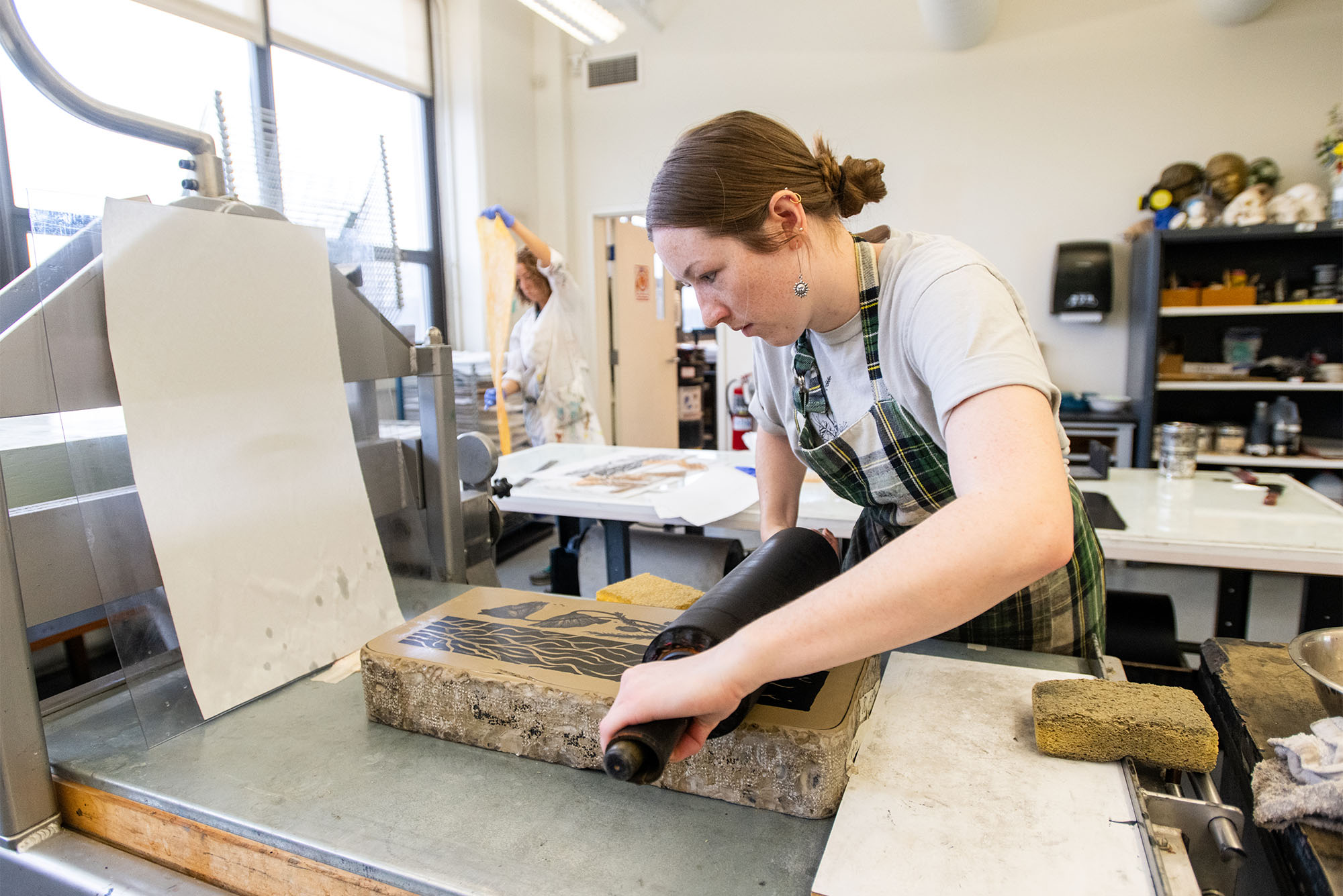
Emily Taylor Rice (CFA’21,’24) and Delaney Burns (CFA’24), both grad students in the College of Fine Arts Print Media & Photography program, working on their respective thesis projects ahead of the School of Visual Arts graduate thesis exhibitions.
Five shows by graduating students in painting, graphic design, sculpture, print media and photography, and visual narrative on view on and off campus through April
Sophie yarin, cydney scott.
As the academic year draws to a close and commencement season approaches, there’s no shortage of reasons to celebrate at the College of Fine Arts. Not only does 2024 mark the school’s 70th birthday— CFA was founded as the School of Fine and Applied Arts in 1954 —but it’s also a year of exciting firsts for the School of Visual Arts and its five Master of Fine Arts programs: painting, sculpture, print media and photography, visual narrative, and graphic design.
This year marks the first that the print media and photography and the visual narrative MFA programs, both launched in 2022, will graduate a class. The 2024 exhibitions also mark the largest cohort to date—61 graduating MFA students—in the school’s history. And for the first time, this year’s shows include an off-campus venue: the sculpture exhibition is being shown at 1270 Commonwealth Ave., where what was once a CVS pharmacy has been transformed into a pop-up art gallery.
All of the exhibitions, on view through April 20, are free and open to the public. Collectively, they offer a sense of the breadth and depth of work being done by MFA students across a range of mediums. For those who cannot make it to all five of this year’s shows, we’ve pulled together some works from each program for your viewing pleasure. But remember: there’s plenty more to see in person.
The visual arts are often compared to a written language, notes Josephine Halvorson , a CFA professor of art, painting, and chair of graduate studies in painting, in the 2024 painting thesis exhibition catalog. “Reading, literacy, and lexicons are terms we frequently cite in critique,” she writes. “Students [have turned] to language, either materially or analogically, to help them navigate meaning in their work.”
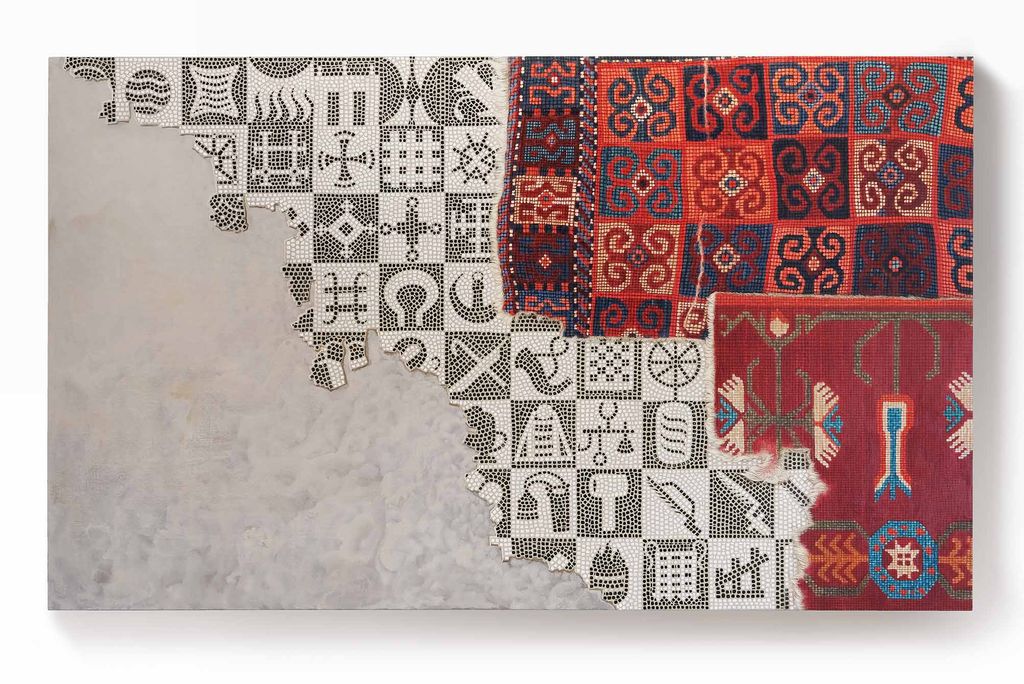
James Gold, Mosaic Excavation with Carpets . Egg tempera, India ink, acrylic gouache, and pigmented gesso on panel.

Abbi Kenny, Atlantic Cranberry Sauce (courtesy of Weight Watchers) . Acrylic, molding paste, acrylic gouache, black pepper, glitter, glass beads, muscovite mica, glass flakes, and yupo collage on canvas.
Some works in this year’s exhibition speak plainly, relying on a strong instinct toward realism and representation. James Gold (CFA’24) imbues his canvases with a photographer’s sense of discovery: his subjects—ancient tapestries, mosaics, and scrolls—are rendered so as to capture every detail and texture.
Paintings by Abigail Kenny (CFA’24) share Gold’s photorealistic sensibility, but her concerns are more outlandish, less rarefied. Vivid-hued reproductions of illustrated recipe cards, from Kenny’s own family collection, comment on Andy Warhol’s iconic soup cans from the early 1960s.
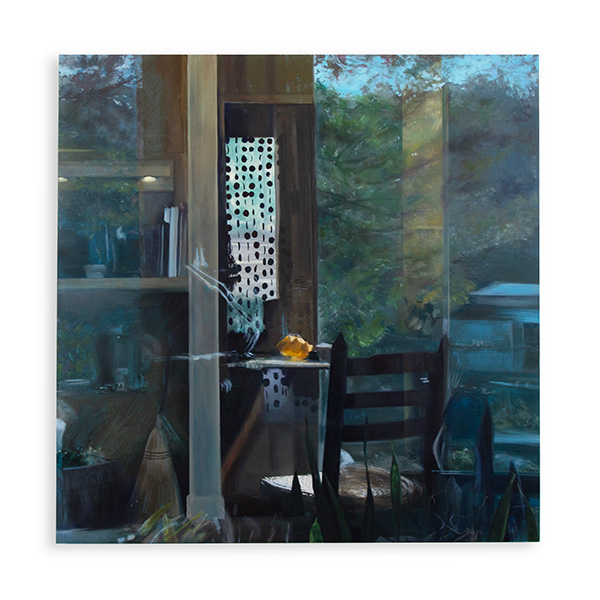
Ellen Weitkamp, Remembering 75 East Cove Lane . Oil on panel.

Cody Bluett, Where Are the Sleeping Fish . Oil and spray paint on canvas, wood carving on frame.
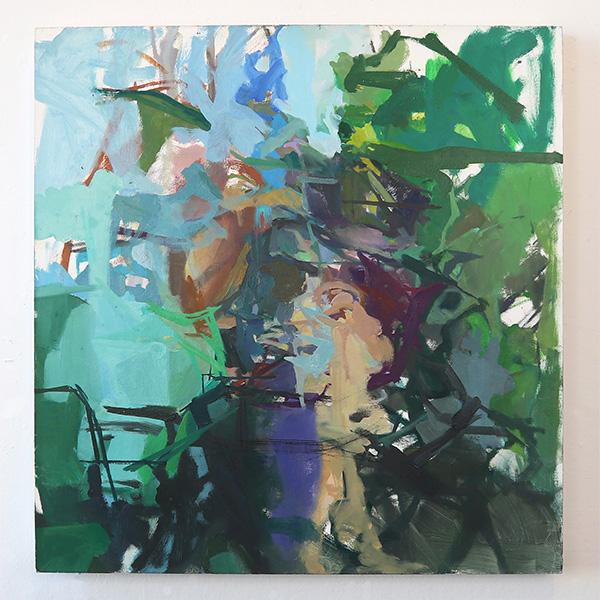
Yingxue Daisy Li, Tunnel. Oil and charcoal on canvas.
Ellen Weitkamp (CFA’24) and Cody Bluett (CFA’24) suffuse their paintings with a more surreal and symbolic language, more poetry than prose. Weitkamp’s works suggest the haziness of recalled memories, depicting domestic scenes through the glass of a storefront or the gauze of a curtain. Bluett is also concerned with memory; drawing from his background in working-class Pennsylvania, his scenes are nostalgic for the bucolic landscapes enjoyed by what he describes as “the proletariat during moments of respite, repetition, and reminiscence.”
Visual language dissolves into whispers and murmurs in paintings by Yinxue Daisy Li (CFA’24). Her abstract landscape works hover on the outer edges of representation, the result of a process of erasing and redrawing that transforms an idyllic outdoor scene into gesture, space, light, and shadow.
The MFA Painting Thesis Exhibition is at the Faye G., Jo, and James Stone Gallery, 855 Commonwealth Ave., through Saturday, April 20. Hours: Tuesday to Saturday, 11 am to 5 pm.
Graphic Design
The theme for this year’s graphic design thesis show, Side B , refers to the flip side of a record, and “a willingness to defy expectations, explore uncommon tools, and present a multifaceted expression of craft,” write thesis advisors Christopher Sleboda , a CFA associate professor of graphic design, and Kristen Coogan , an associate professor of graphic design and chair of the MFA graphic design program, in the catalog for the show.
For her thesis project, Between Waves , Bella Tuo (CFA’24) literally crowdsourced a new font. Over the course of a day, she encouraged strangers to contribute a hand-drawn line, curve, or serif until each letter of the alphabet was complete .

Bella Tuo, Between Waves project feat. Rainbow Hui. Digital media.
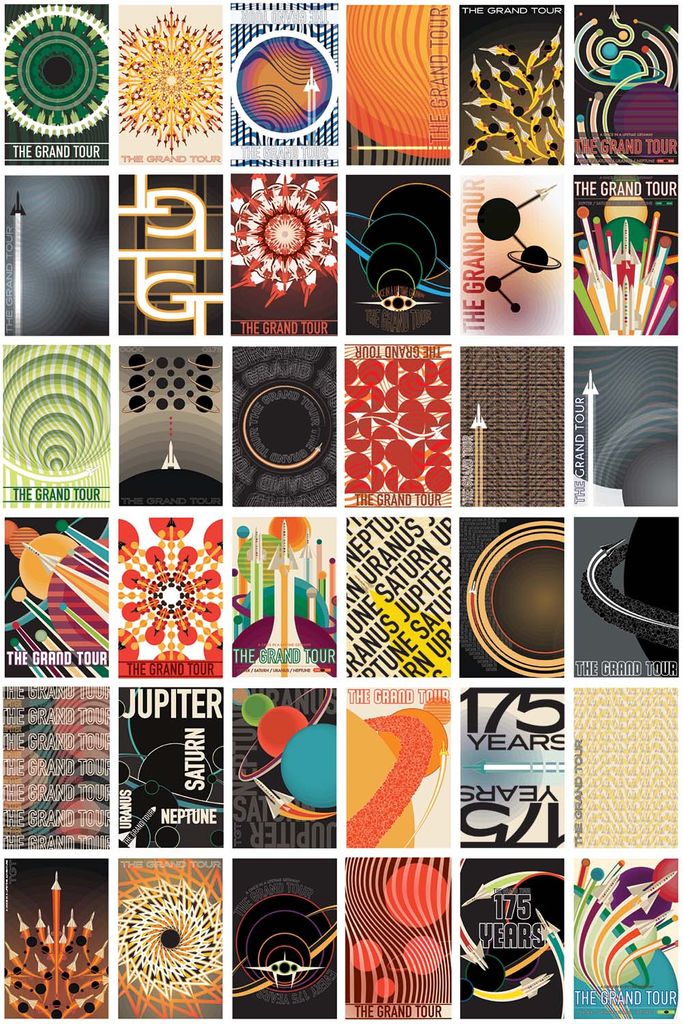
Arjun Lakshmanan, The Grand Tour-50 Iterations. Digital media.
Arjun Lakshmanan (CFA’24) was inspired by a NASA mock travel poster that imagined interplanetary tourism. With the same retro futuristic style, he produced a series of 50 similar postcards that emphasized three-dimensionality and warped perception.
Lindsay Towle (CFA’24), whose design sensibility is informed by the graphic imprint of basketball and other facets of urban street culture, devised new aesthetic associations that make room for visual subcultures within the dominant narrative. A poster of her thesis concept, Backcourt , mixes graffiti lettering, a hallmark of elements of street culture, with classic typography and handwritten elements.
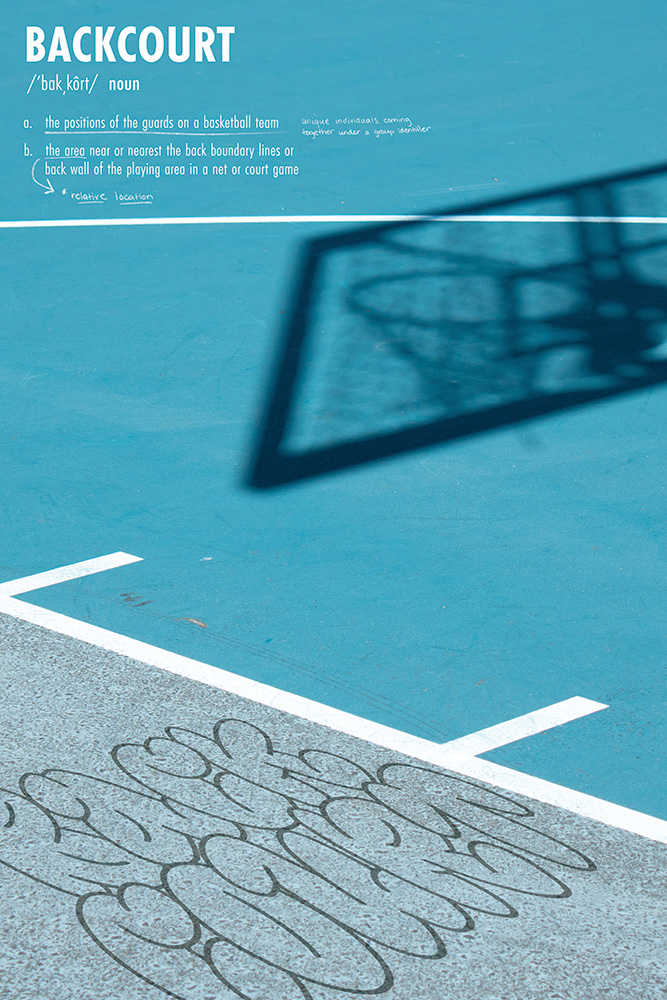
Lindsay Towle, The Backcourt . Digital media.

Carolina Izsak, Masking Tape Proportionality . Belgian linen.
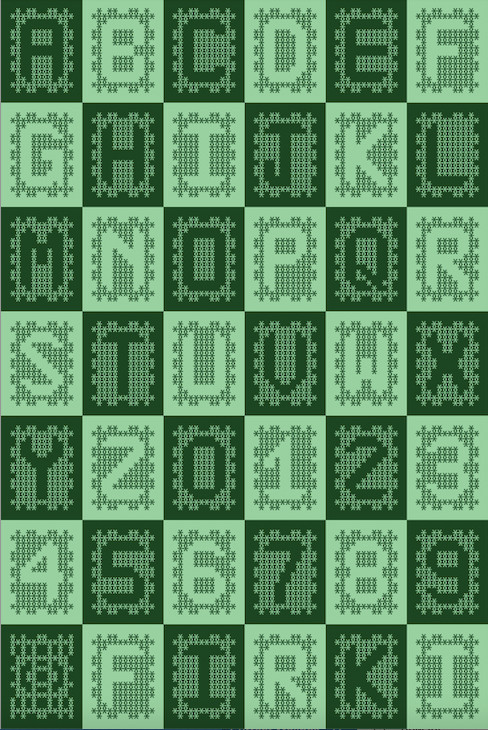
Dhwani Garg, Firki typeface. Digital media.
“The relationships between structure and emotion, constraints and freedom, and a set of parts and pieces to create a whole have always been part of my practice as a designer,” Carolina Izsak (CFA’24) writes. Bursting with color and built to foster interaction and joy, Izsak’s thesis project—which includes prints she has laid onto fabric and wooden blocks—emphasizes playfulness and versatility.
Firki , a typeface created by Dhwani Garg (CFA’24), considers the scalability of typography in a new way. The font uses negative space to construct each figure, an inversion of the simple and expected formula used since the dawn of typesetting.
The MFA Graphic Design Thesis Exhibition is at the 808 Gallery, 808 Commonwealth Ave., through Saturday, April 20. Hours: Tuesday to Saturday, 11 am to 5 pm.
Visual Narrative
The first graduating class of the MFA visual narrative program has created a collection of work that runs the storytelling gamut, crafting work that’s “humorous, poignant, and thought-provoking,” writes Joel Christian Gill , a CFA associate professor of art and chair of the visual narrative program.
Sadie Saunders (CFA’24) and Ella Scheuerell (CFA’24) both opted to create graphic memoirs, and although their methodologies differ (Saunders uses digital drawing while Scheuerell relies on collage and mixed media), their stories are grounded in their experiences as young artists coming of age in the pandemic era. Scheuerell introduces readers to her uncle, whose art she discovered among his effects after his death by suicide. As she comes to terms with his loss, the drawings and his invisible presence keep her company. Saunders’ work reads more like a memoir-slash-sitcom, a self-deprecating tour of her barista job and the cast of characters who challenge her to find her voice.

Sadie Saunders, pages from Spilled Milk and Other Reasons to Cry at Work . Digital drawing.
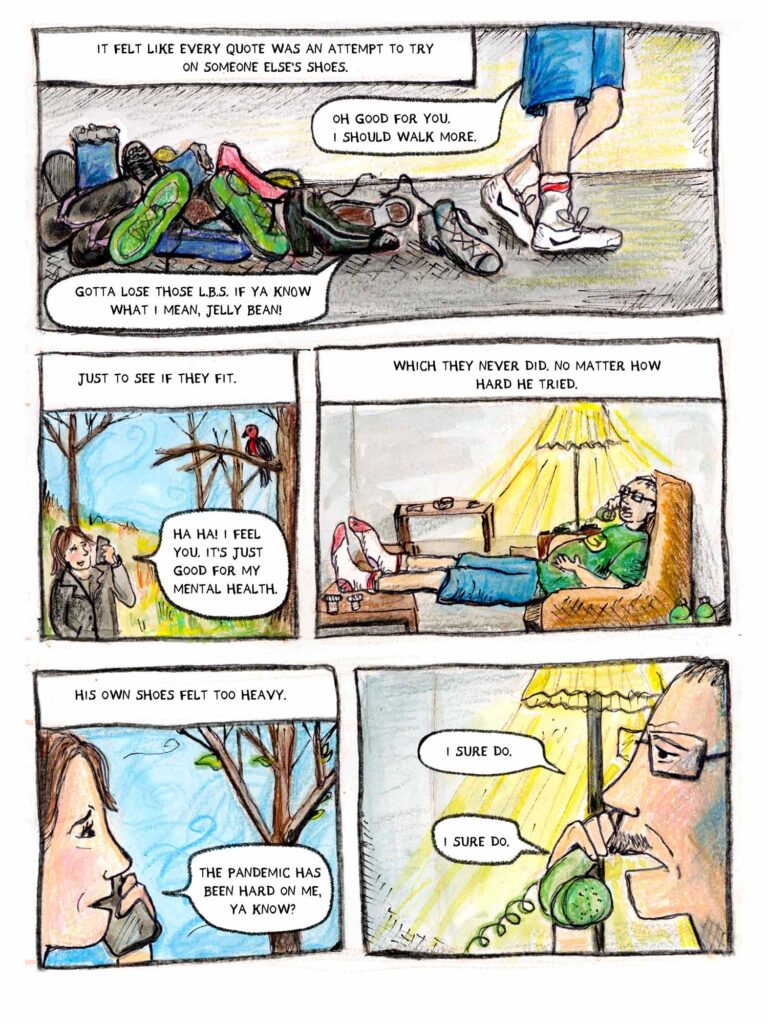
Ella Scheurell, Heavy Shoes , Colored pencil, watercolor sharpie on paper.
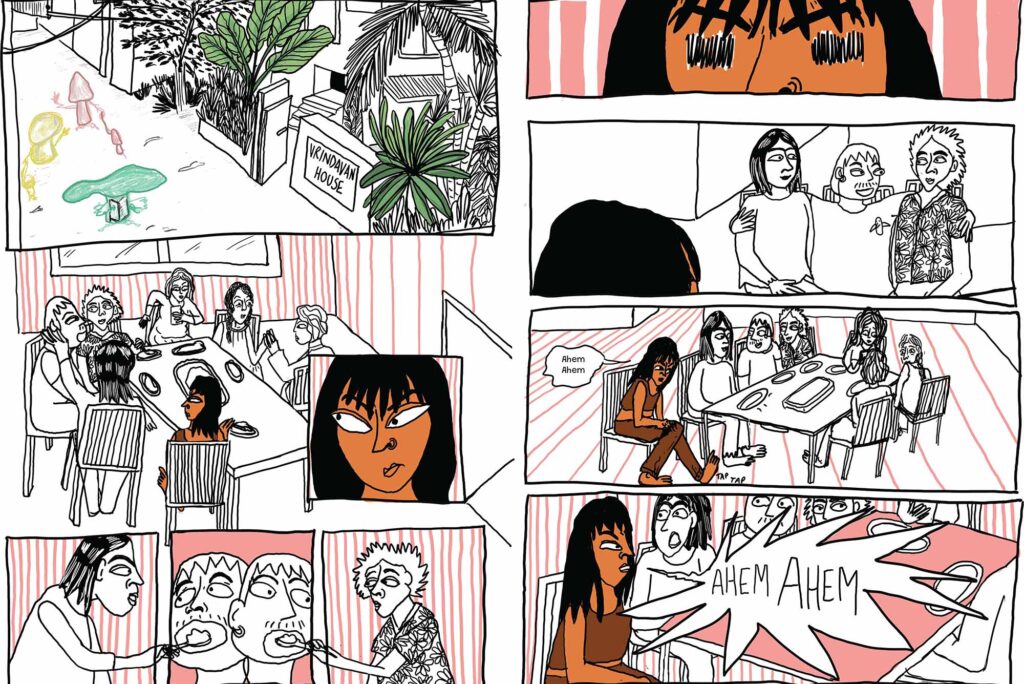
Avanji Vaze, page from Vrindavan House . Digital drawing.
Works by Avanji Vaze (CFA’24), Sandeep Badal (CFA’24), and Ariel Cheng Kohane (COM’22, CFA’24) have created stories that revel in invented universes and complex plotlines. Vaze’s graphic novel combines a Utopian fairytale (where Earth is run by a species of benevolent mushrooms) and MTV’s The Real World , centering a lovable-but-dysfunctional crew of artist roommates as her main cast. Badal’s thesis work is a comic within a comic; his protagonist, a graphic novelist, shares the stage with his own invented character, a trans-femme superhero who begins to feel like the world is treating her like a villain. And Cheng Kohane’s world is a reimagination of classic Western flicks, but populated by a cast of Asian and Jewish characters to match her own blended heritage.
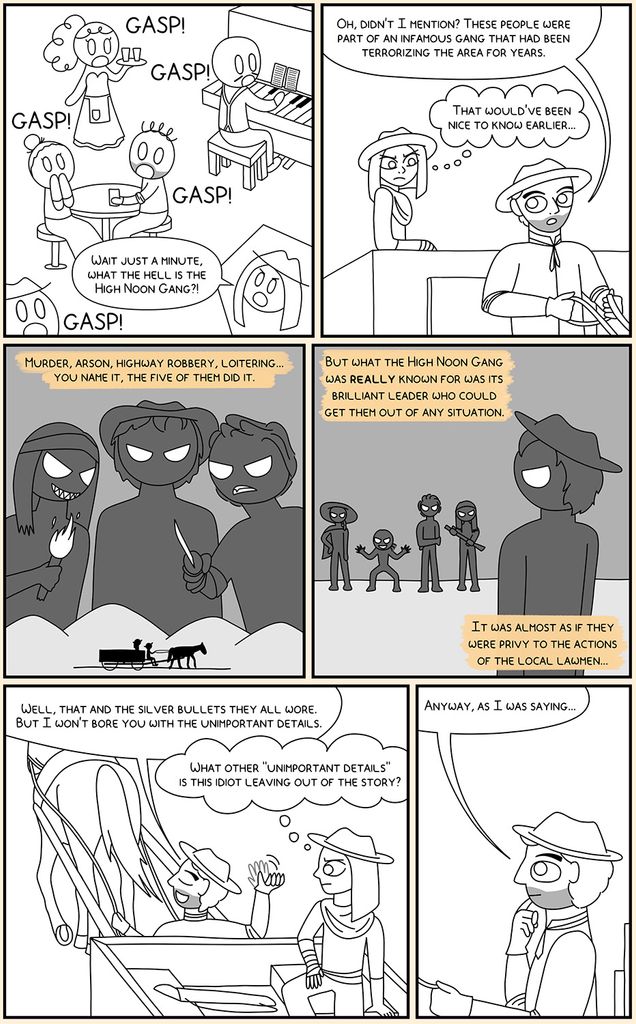
Ariel Kohane, page from Hai Noon . Digital drawing.
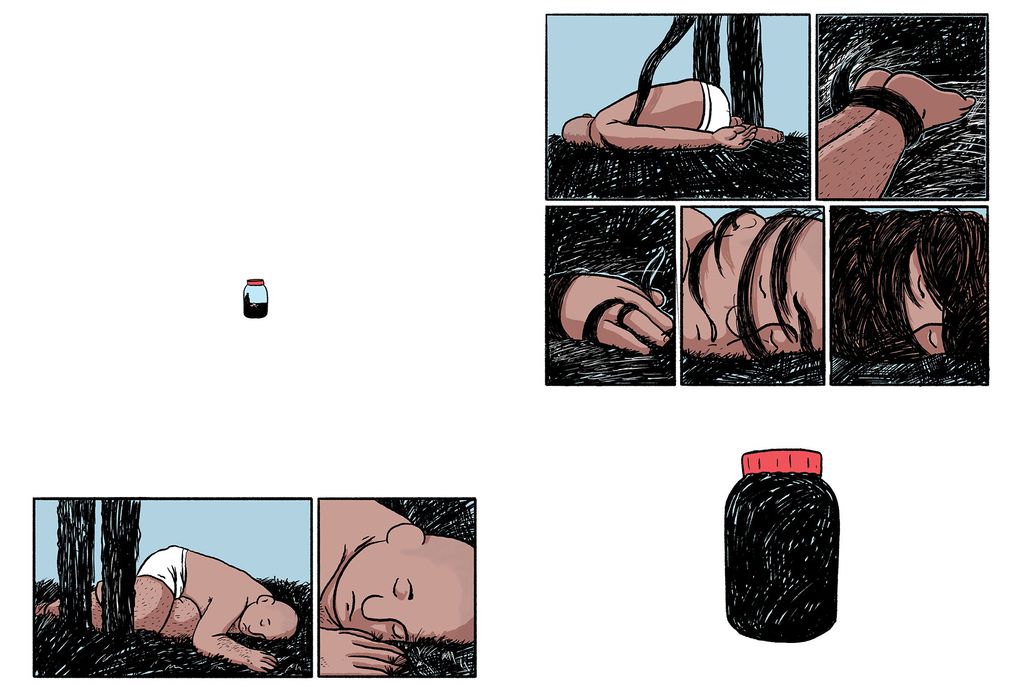
Sandeep Badal, two-page spread from Phantom in a Jar . Digital drawing.
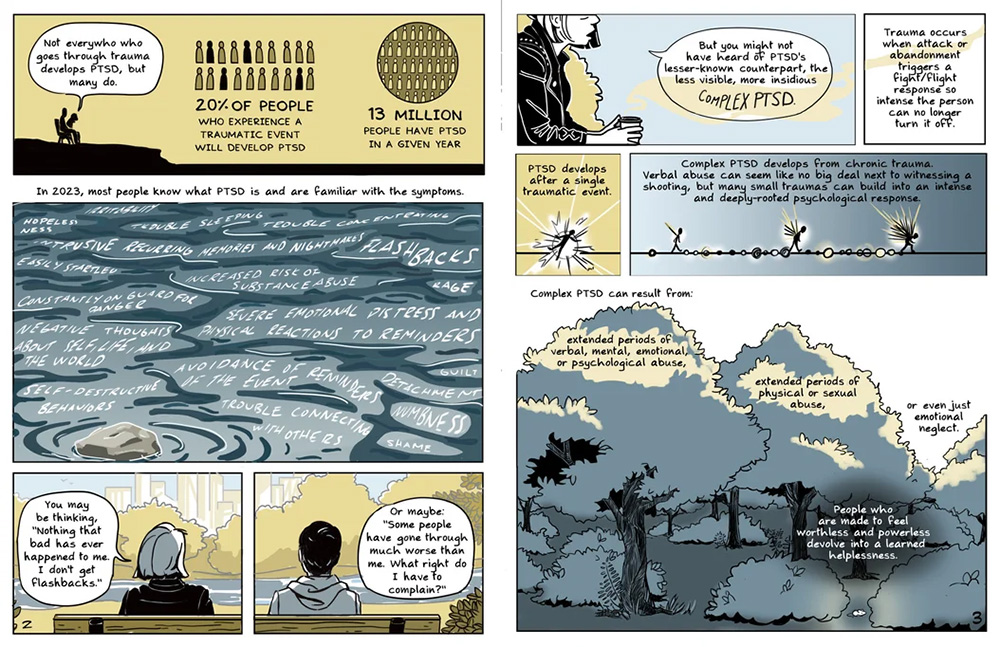
Lafleche Giasson, two-page spread from New Leaves on the Tree: How Intergenerational Trauma Affects Inheritable Gene Expression . Digital drawing.
For her thesis, Lafleche Giasson (CFA’24) chose an unconventional narrative, opting to blend her research on complex post-traumatic stress disorder with digital illustrations to create a comprehensive visual guide to the diagnosis.
The MFA Visual Narrative Thesis Exhibition is at the Commonwealth Gallery, 855 Commonwealth Ave., through Saturday, April 20. Hours: Tuesday to Saturday, 11 am to 5 pm. Students will present their thesis work on Wednesday, April 10, and Friday, April 12, from 3 to 5 pm at the Howard Thurman Center, 808 Commonwealth Ave.
Print Media & Photography
This year’s graduates of the pPrint media and photography MFA program have created work that “disrupt[s] the viewer’s sense of the familiar and, in turn, prompt[s] more questions than answers,” write thesis advisors Lynne Allen , a CFA professor of art, printmaking, Toni Pepe , a CFA assistant professor of art and chair of photography, and Deborah Cornell , a CFA professor of art and chair of printmaking, in the show’s catalog. The four graduates whose work is in the thesis show have subverted the expected with their thesis work, in the process highlighting a core principle of printmaking: that it’s a medium of endless possibilities.
The photographs of Sofia Barroso (CFA’24) have been processed to the point of distortion, incorporating fabric, paper, thread, paint, and processes like cyanotype and silkscreen printing.
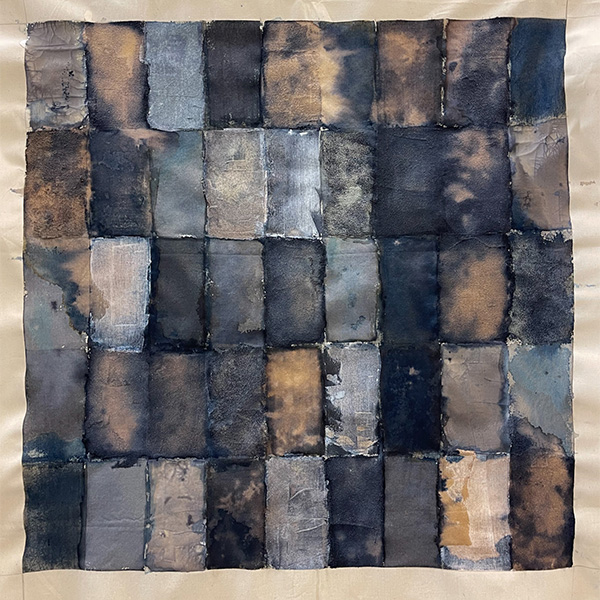
Sofia Barroso, Exploration of Possibilities . Cyanotype on fabric.

Julianne Dao, Walking Shadows . Collagraph, Chiné-colle archival inkjet print.
Julianne Dao (CFA’24) creates prints that play with negative space; each of her prints began with an object from nature, which she then processed through woodcut, embossing, and other techniques to create a bold design full of light and shadow.
Emily Taylor Rice (CFA’21,’24) and Delaney Burns (CFA’24) injected messages of social activism into their works: Rice creates prints that reflect the emotional turmoil of substance use disorders, using found textiles and colored pigments to reflect the chaos of alcohol dependence and utilizing embossing techniques to replicate emotional scars and ripped-and-torn sections to represent a process of deconstruction and rebirth.
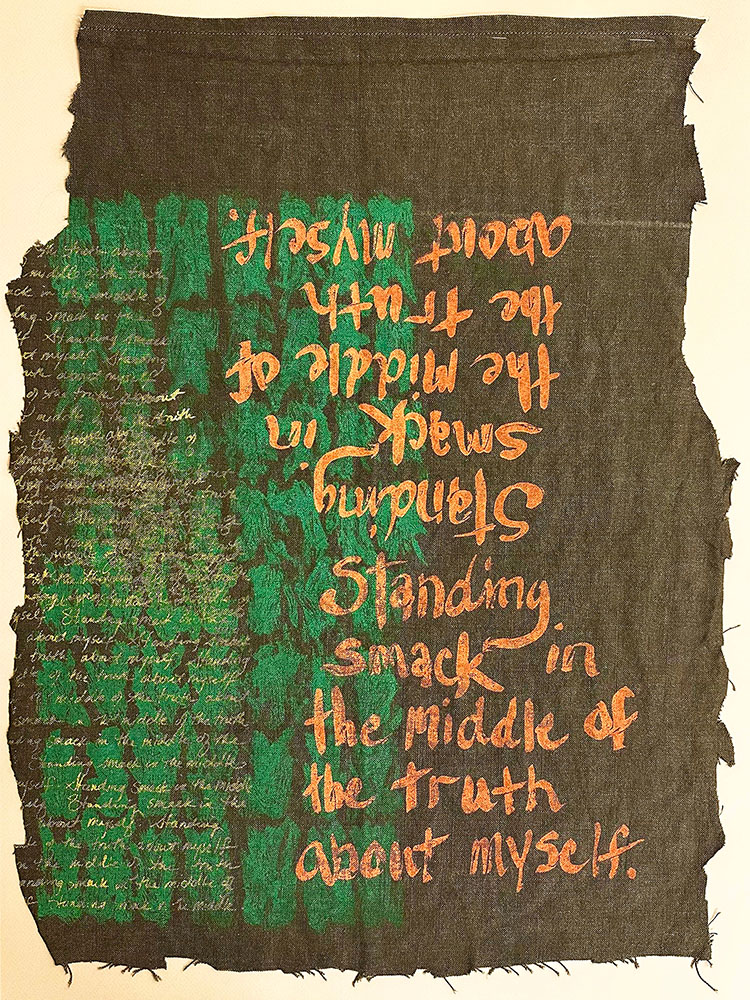
Emily Taylor Rice, Standing Smack in the Middle of the Truth About Myself . Silkscreen on found fabric.

Delaney Burns, One In Four. Screenprint on tea bags with peacock flower seeds and birth control pamphlets.
Burns incorporates items from all aspects of her life—plants from her mother’s garden; diary entries, notes, and cards written by women in her family; birth control pamphlets; and used teabags—to draw attention to what she says are the unseen, misunderstood, and taken-for-granted experiences of women. Techniques such as bookbinding and wood carving mirror domestic tasks, imbuing her process with a metaphysical interaction with traditional gender roles.
The MFA Print Media & Photography Thesis Exhibition is at the 808 Gallery, 808 Comm Ave., through Saturday, April 20. Hours: Tuesday to Saturday, 11 am to 5 pm.
The pieces in the MFA sculpture exhibition may have little in common visually, writes David Snyder , a CFA assistant professor of sculpture and chair of graduate studies in sculpture, “but what they have built together is…a conversation, a culture, a language, a heart.”
The works by the five students included in this year’s show respond to one another, playing on unconventional uses of space.
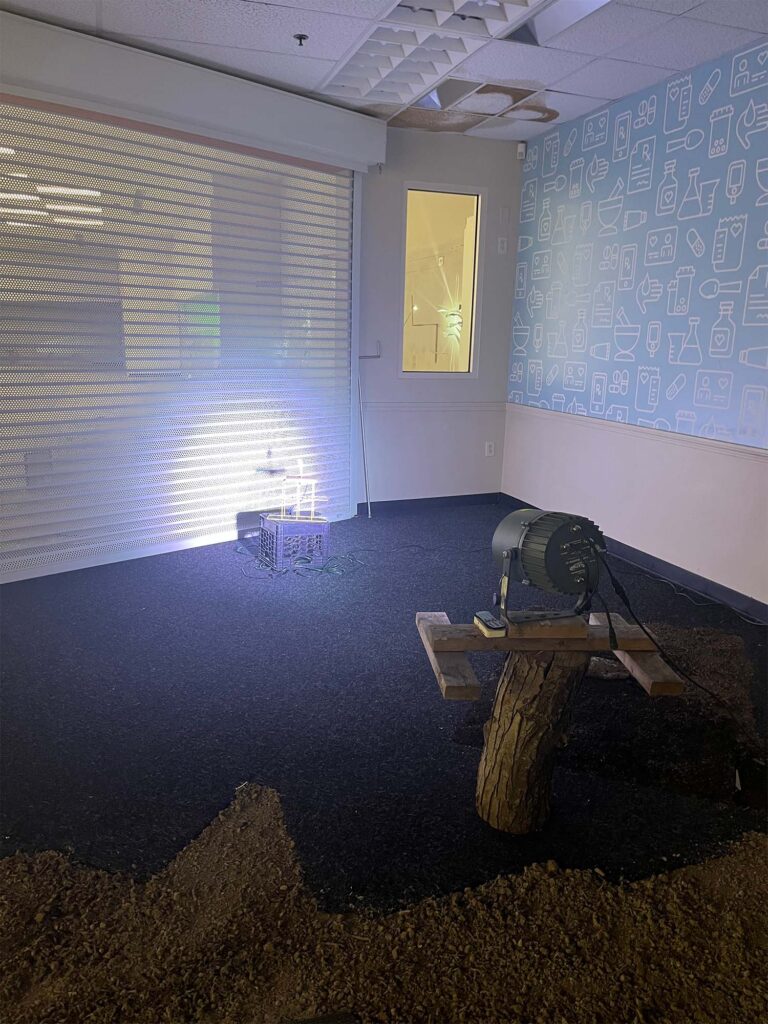
Yolanda He Yang, section of Sand Floor and Two Holes to the Basement and Happenings on the Wall. Piano strings, sand, LED spotlight and motor, glass, projector, wood, plastic sheet, mylar, telephone wires, marble.
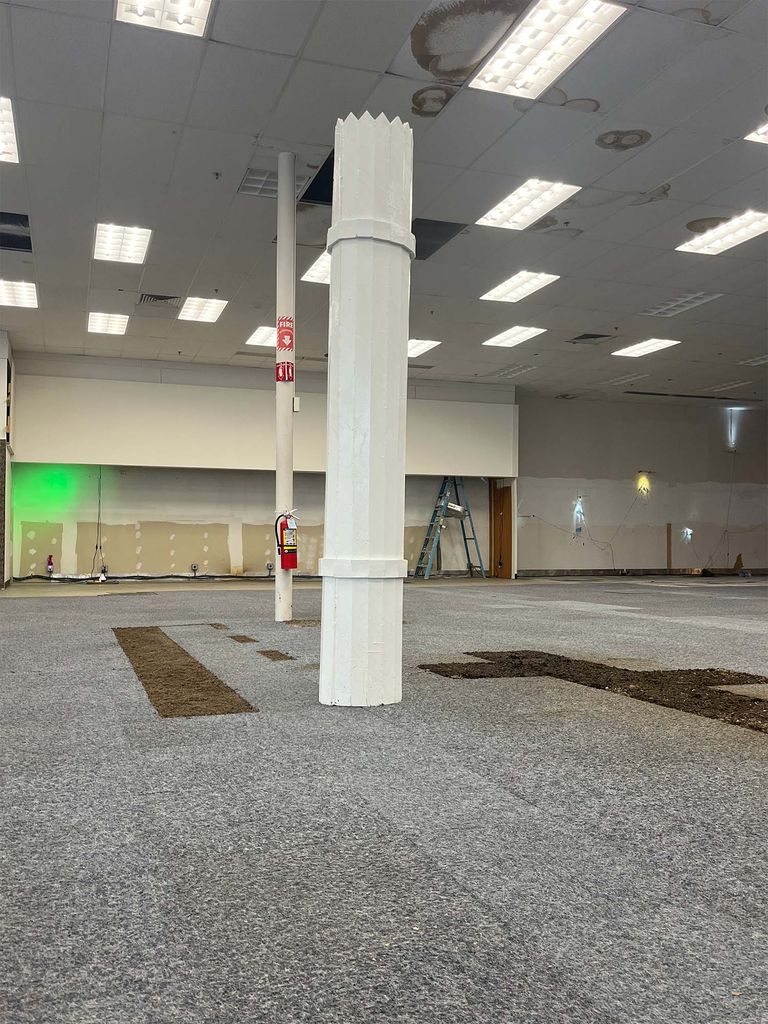
Helena Abdelnasser, I think it’s dying. Wood, hinges, screws, white paint, soil, grass seeds, plastic bag, water, unfired clay, baby monitor.
In one area, a section of a piece by Yolanda He Yang (MET’21, CFA’24) shares room with a pillar constructed by Helena Abdelnasser (CFA’24). Yang’s sprawling narrative installations include materials that evoke personal significance, and the artist has painstakingly cataloged the origins of each object. The result: an annotated roadmap of a memory. Looming nearby is one of Abdelnasser’s sculptures: an obelisk made of whitewashed picket fences planted in a patch of earth—an untouchable idealization. In one corner of the work, blurred by decay and dirt, is a reproduction of a dead bird—a gruesome reality.
Alyssa Grey (CFA’24) is fascinated by the relationship between art and its modes of display—walk past one of her entries and a motion-sensing camera will project you onto a small television mounted on a plywood pedestal. Mae-Chu Lin O’Connell (CFA’24) injects a self-deprecating, almost paranoiac sensibility in each of her works, making liberal use of claustrophobia, clutter, sensory discomfort, and haphazardness in her installations and videos. Boxmaker , a scattered assemblage of objects in the shadow of an assembled piece of box furniture, brims with frustration, while her videos create an eerie sound collage out of the banal act of eating.

Alyssa Grey, HomeVideos . Wood, roof sealant, plywood, TV, electrical cords, camouflage duct tape, DC motor, camera.

Mae-Chu Lin O’Connell , Boxmaker (How to build a 36-drawer Wunderkabinett in a week) . Plywood, brass knobs, casters, wood screws, wood glue, epoxy, screws, nails, wood putty, and various objects.
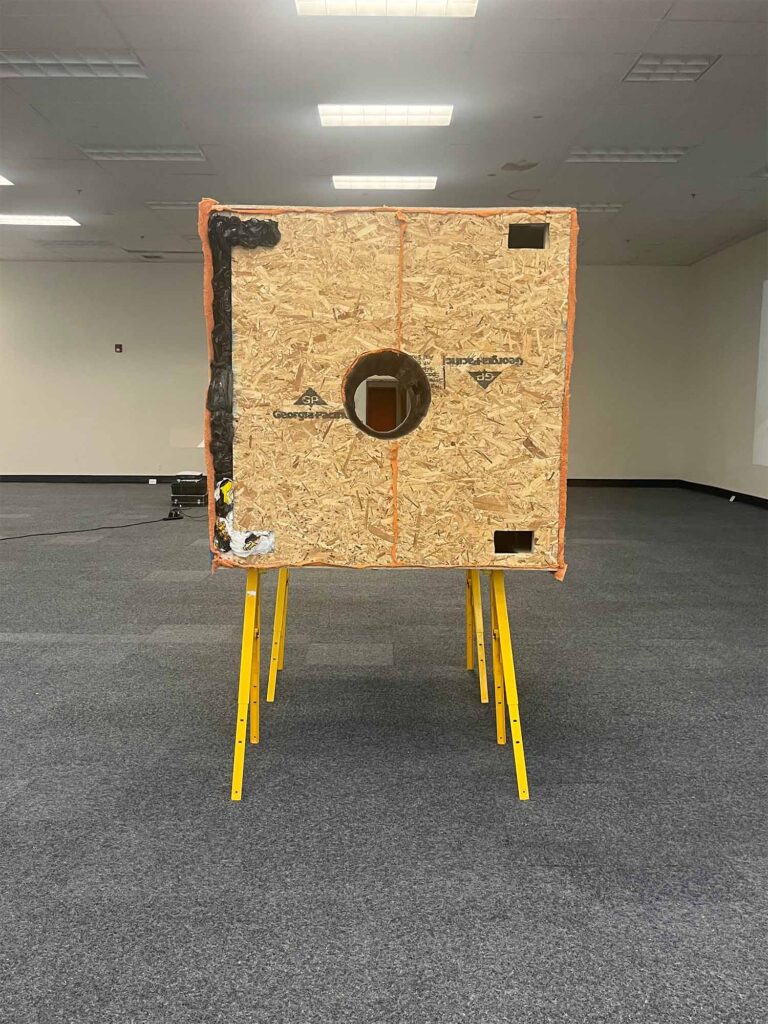
Liam Coughlin, r/decks . OSB, dimensional lumber, towels, salvaged floor boards, adhesives and fasteners, plastic bags, garbage bags, Gatorade bottle full of spit, PEZ dispenser, sawhorses, sawdust.
Meanwhile, Liam Coughlin’s work addresses the sociopolitical landscape of the suburbs. Coughlin (CFA’24) encases trash—plastic bags and bottles, Halloween pumpkins, fast food cups—in plywood prisons to replicate “growing up in a homogenized, hermetically sealed, village-like culture of a small New England town.”
The MFA Sculpture Thesis Exhibition is at 1270 Commonwealth Ave., through Saturday, April 20. Hours: Tuesdays, Wednesdays, Fridays, and Saturdays, 11 am to 5 pm, and Mondays and Thursdays by appointment.
- Share this story
- 0 Comments Add
Associate Editor, BU Today; Managing Editor Bostonia

Sophie Yarin is a BU Today associate editor and Bostonia managing editor. She graduated from Emerson College's journalism program and has experience in digital and print publications as a hybrid writer/editor. A lifelong fan of local art and music, she's constantly on the hunt for stories that shine light on Boston's unique creative communities. She lives in Jamaica Plain with her partner and their cats, Ringo and Xerxes, but she’s usually out getting iced coffee. Profile
Photojournalist

Cydney Scott has been a professional photographer since graduating from the Ohio University VisCom program in 1998. She spent 10 years shooting for newspapers, first in upstate New York, then Palm Beach County, Fla., before moving back to her home city of Boston and joining BU Photography. Profile
Comments & Discussion
Boston University moderates comments to facilitate an informed, substantive, civil conversation. Abusive, profane, self-promotional, misleading, incoherent or off-topic comments will be rejected. Moderators are staffed during regular business hours (EST) and can only accept comments written in English. Statistics or facts must include a citation or a link to the citation.
Post a comment. Cancel reply
Your email address will not be published. Required fields are marked *
Latest from BU Today
Bu’s sargent college named nation’s top occupational therapy program in u.s. news 2024 best graduate schools rankings, rats does boston need a “rat czar”, pov: you’re using the wrong door—and there’s a reason, your everything guide to living off campus, bu marks 50 years of changing lives behind bars, $100,000 awarded to student entrepreneurs at sha’s annual hospitality leadership summit, bu’s earth day celebrations, tenth annual giving day raises more than $3.8 million, bu freshman macklin celebrini named a hobey baker award finalist, photos of the month: a look back at march at bu, what’s hot in music this month: new releases, local concerts, the weekender: april 4 to 7, could this be the next snl bu student’s wicked smaht comedy troupe performs this weekend, determined to make the world a better place, giving day 2024: bu celebrates 10 years of giving back, your everything guide to landing an internship, building a powerhouse: how ashley waters put bu softball on the map, sex in the dark: a q&a event with sex experts, tips to watch and photograph the april 8 total solar eclipse safely, for cfa’s head of acting, huntington role required discretion, listening.
Have a language expert improve your writing
Run a free plagiarism check in 10 minutes, generate accurate citations for free.
- Knowledge Base
- Dissertation
Prize-Winning Thesis and Dissertation Examples
Published on September 9, 2022 by Tegan George . Revised on July 18, 2023.
It can be difficult to know where to start when writing your thesis or dissertation . One way to come up with some ideas or maybe even combat writer’s block is to check out previous work done by other students on a similar thesis or dissertation topic to yours.
This article collects a list of undergraduate, master’s, and PhD theses and dissertations that have won prizes for their high-quality research.
Instantly correct all language mistakes in your text
Upload your document to correct all your mistakes in minutes

Table of contents
Award-winning undergraduate theses, award-winning master’s theses, award-winning ph.d. dissertations, other interesting articles.
University : University of Pennsylvania Faculty : History Author : Suchait Kahlon Award : 2021 Hilary Conroy Prize for Best Honors Thesis in World History Title : “Abolition, Africans, and Abstraction: the Influence of the “Noble Savage” on British and French Antislavery Thought, 1787-1807”
University : Columbia University Faculty : History Author : Julien Saint Reiman Award : 2018 Charles A. Beard Senior Thesis Prize Title : “A Starving Man Helping Another Starving Man”: UNRRA, India, and the Genesis of Global Relief, 1943-1947
University: University College London Faculty: Geography Author: Anna Knowles-Smith Award: 2017 Royal Geographical Society Undergraduate Dissertation Prize Title: Refugees and theatre: an exploration of the basis of self-representation
University: University of Washington Faculty: Computer Science & Engineering Author: Nick J. Martindell Award: 2014 Best Senior Thesis Award Title: DCDN: Distributed content delivery for the modern web
Prevent plagiarism. Run a free check.
University: University of Edinburgh Faculty: Informatics Author: Christopher Sipola Award: 2018 Social Responsibility & Sustainability Dissertation Prize Title: Summarizing electricity usage with a neural network
University: University of Ottawa Faculty: Education Author: Matthew Brillinger Award: 2017 Commission on Graduate Studies in the Humanities Prize Title: Educational Park Planning in Berkeley, California, 1965-1968
University: University of Ottawa Faculty: Social Sciences Author: Heather Martin Award: 2015 Joseph De Koninck Prize Title: An Analysis of Sexual Assault Support Services for Women who have a Developmental Disability
University : University of Ottawa Faculty : Physics Author : Guillaume Thekkadath Award : 2017 Commission on Graduate Studies in the Sciences Prize Title : Joint measurements of complementary properties of quantum systems
University: London School of Economics Faculty: International Development Author: Lajos Kossuth Award: 2016 Winner of the Prize for Best Overall Performance Title: Shiny Happy People: A study of the effects income relative to a reference group exerts on life satisfaction
University : Stanford University Faculty : English Author : Nathan Wainstein Award : 2021 Alden Prize Title : “Unformed Art: Bad Writing in the Modernist Novel”
University : University of Massachusetts at Amherst Faculty : Molecular and Cellular Biology Author : Nils Pilotte Award : 2021 Byron Prize for Best Ph.D. Dissertation Title : “Improved Molecular Diagnostics for Soil-Transmitted Molecular Diagnostics for Soil-Transmitted Helminths”
University: Utrecht University Faculty: Linguistics Author: Hans Rutger Bosker Award: 2014 AVT/Anéla Dissertation Prize Title: The processing and evaluation of fluency in native and non-native speech
University: California Institute of Technology Faculty: Physics Author: Michael P. Mendenhall Award: 2015 Dissertation Award in Nuclear Physics Title: Measurement of the neutron beta decay asymmetry using ultracold neutrons
University: Stanford University Faculty: Management Science and Engineering Author: Shayan O. Gharan Award: Doctoral Dissertation Award 2013 Title: New Rounding Techniques for the Design and Analysis of Approximation Algorithms
University: University of Minnesota Faculty: Chemical Engineering Author: Eric A. Vandre Award: 2014 Andreas Acrivos Dissertation Award in Fluid Dynamics Title: Onset of Dynamics Wetting Failure: The Mechanics of High-speed Fluid Displacement
University: Erasmus University Rotterdam Faculty: Marketing Author: Ezgi Akpinar Award: McKinsey Marketing Dissertation Award 2014 Title: Consumer Information Sharing: Understanding Psychological Drivers of Social Transmission
University: University of Washington Faculty: Computer Science & Engineering Author: Keith N. Snavely Award: 2009 Doctoral Dissertation Award Title: Scene Reconstruction and Visualization from Internet Photo Collections
University: University of Ottawa Faculty: Social Work Author: Susannah Taylor Award: 2018 Joseph De Koninck Prize Title: Effacing and Obscuring Autonomy: the Effects of Structural Violence on the Transition to Adulthood of Street Involved Youth
If you want to know more about AI for academic writing, AI tools, or research bias, make sure to check out some of our other articles with explanations and examples or go directly to our tools!
Research bias
- Survivorship bias
- Self-serving bias
- Availability heuristic
- Halo effect
- Hindsight bias
- Deep learning
- Generative AI
- Machine learning
- Reinforcement learning
- Supervised vs. unsupervised learning
(AI) Tools
- Grammar Checker
- Paraphrasing Tool
- Text Summarizer
- AI Detector
- Plagiarism Checker
- Citation Generator
Cite this Scribbr article
If you want to cite this source, you can copy and paste the citation or click the “Cite this Scribbr article” button to automatically add the citation to our free Citation Generator.
George, T. (2023, July 18). Prize-Winning Thesis and Dissertation Examples. Scribbr. Retrieved April 9, 2024, from https://www.scribbr.com/dissertation/examples/
Is this article helpful?
Tegan George
Other students also liked, how to choose a dissertation topic | 8 steps to follow, checklist: writing a dissertation, thesis & dissertation database examples, unlimited academic ai-proofreading.
✔ Document error-free in 5minutes ✔ Unlimited document corrections ✔ Specialized in correcting academic texts
Social Robot Interaction Design to Mitigate Risk in Sensitive and Adverse Contexts
Publication Year
Share this:
- Click to share on Twitter (Opens in new window)
- Click to share on Facebook (Opens in new window)
- Click to share on LinkedIn (Opens in new window)
- Undergraduate Degree Programs
- Graduate Degree Programs
- Summer Session Courses
- Accreditation
- Department of Architecture
- Department of Art History
- Department of Graphic Design
- Department of Landscape Architecture
- School of Music
- School of Theatre
- School of Visual Arts
- Stuckeman School
- Research & Creativity
- Centers and Initiatives
- Performances & Exhibitions
- Event Calendar
- Palmer Museum of Art
- Center for the Performing Arts
- Penn State Centre Stage
- Penn's Woods Music Festival
- Penn State Blue Band
- Schools, Units and Offices
This dialog contains the full navigation menu for arts.psu.edu.
College of Arts & Architecture
Resources For
- Parents and Guardians
- Alumni and Friends
- Academic Advising
- Access and Equity
- Digital Learning
- Sustainability
Helpful Links
- Notes from the Dean
- Buy Event Tickets
- Parking at Penn State
- Plan a Visit
- Careers with A&A

Social Media
"echoes & edges," a graphic design thesis exhibition, reception.

Date & Time: April 17, 2024 from 05:00 PM - 07:00 PM
Event Sponsors: Graphic Design, Stuckeman School, Receptions
College of Arts and Architecture students who are wrapping up their studies for their master of fine arts degrees with a concentration in graphic design this spring are hosting a thesis exhibition of projects dedicated to enhancing lives through human-centered design April 15-19 in the Borland Project Space (125 Borland Building, University Park).
Titled “Echoes and Edges,” the exhibition will be open from 9 a.m. to 4 p.m. daily with a reception to be held from 5-7 p.m. April 17. The three graduating students will be on hand to discuss their projects, which are digital applications (apps) that are focused on self-improvement. Viewers will be able explore how each project brings creativity and intention together to encourage better well-being and offer solutions to elevate the human experience.
Forough Yazdan Panah will give an artist’s talk on her app, titled “Flourish,” at noon on April 16. Flourish is tailored to generate greater empathy and understanding of the diverse range of human experiences. To appreciate and validate the lived experience of highly sensitive individuals, the app is also designed for them to cope with intense stress and pressure, be productive and perform self-care. The app considers the impact of societal expectations on mental health, emotional expression and identity formation, particularly among marginalized populations and highly sensitive individuals.
Jordan Wolf’s app, titled “Gracefully,” is a mobile app to foster forgiveness among young adults. She will present her artist’s talk at noon on April 18. Gracefully encourages forgiveness as a form of self-care and highlights its profound impact on one’s health. Through guided reflections and interactive exercises, users cultivate forgiveness habits, enhance emotional resilience and foster better well-being. Gracefully provides a transformative digital space for users to engage in this vital practice.
Negar Dehghan’s app, titled “Glucomood,” is designed for adolescents with Type 1 diabetes (T1D). She will present an artist talk at 3 p.m. April 18 to discuss her project. Glucomood addresses the dual challenges of diabetes management and mental well-being with functions for tracking blood glucose levels and mood to understand their correlation, a journal for personal reflections, meditation exercises designed to address the specific challenges of living with T1D and interactive games that encourage the adoption of healthy lifestyle habits. Glucomood also includes a community section that enables users to connect, share their experiences and support each other.
The master of fine arts degree with a concentration in graphic design is offered by the Stuckeman School in conjunction with the School of Visual Arts in the College of Arts and Architecture.
Legal Statements
- Non-Discrimination
- Equal Opportunity
- Accessibility
- The Pennsylvania State University © 2024
- myState on Mississippi State University
- Directory on Mississippi State University
- Alumni & Friends
CHANNEL 26: Graphic Design Senior Thesis Exhibition
April 17, 2024
Cullis Wade Depot Art Gallery, Visual Arts Center Gallery
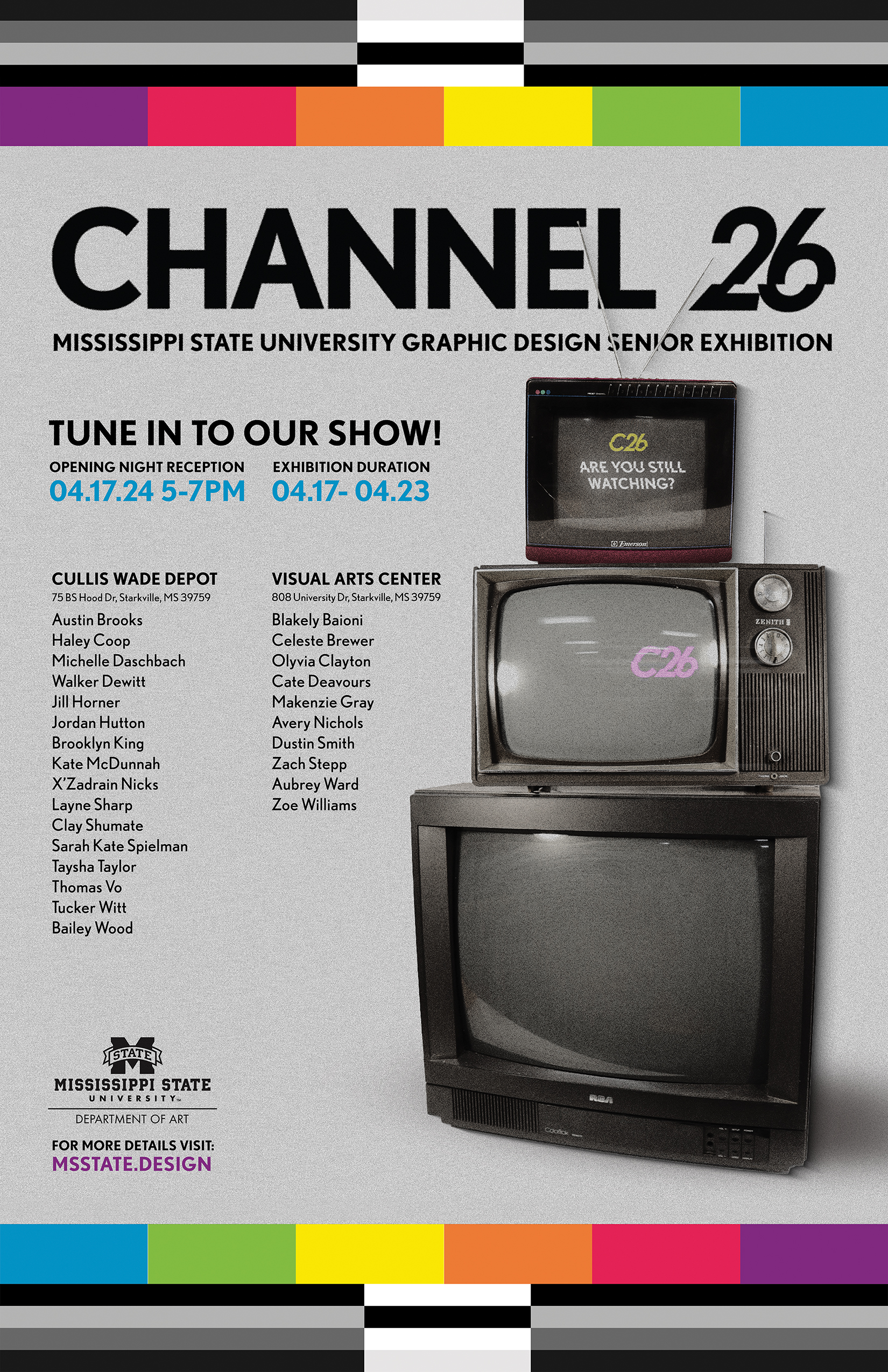
Research Centers
- Fred Carl, Jr. Small Town Center
- Gulf Coast Community Design Studio
Alumni / Friends
- Advisory Boards
- Alumni Events
- Alumni News
- Featured Supporters
- Keep In Touch
- Architecture News
- Building Construction Science News
- Interior Design News
- Photo Collections
- Upcoming Events
- Admissions Questions
- CAAD Directory
- Office Contacts
Architecture
(662) 325-2202
(662) 325-2970
Building Construction Science
(662) 325-8305
Interior Design
(662) 325-0530
Dean's Office
(662) 325-5150
- Find College of Architecture, Art, and Design on Facebook
- Find College of Architecture, Art, and Design on Instagram
- Find College of Architecture, Art, and Design on X Twitter
- Find College of Architecture, Art, and Design on YouTube
- Find College of Architecture, Art, and Design on Vimeo

IMAGES
VIDEO
COMMENTS
01. Treat it like a design brief. "A great dissertation should be a designed artefact, and portfolio-worthy in its own right," says Burston. And like a design brief, it should be about solving a problem: "Make sure it has clearly stated aims, strong focus, and doesn't lack opinion or rhetoric," he adds. "The value of a designed dissertation as ...
Dissertations on Design. Design is utilised in a broad range of industries and could include any number of different subjects from architecture and interior design, to products, packaging, logos, vehicles or anything in between. View All Dissertation Examples.
Time to recap…. And there you have it - the traditional dissertation structure and layout, from A-Z. To recap, the core structure for a dissertation or thesis is (typically) as follows: Title page. Acknowledgments page. Abstract (or executive summary) Table of contents, list of figures and tables.
A research design is a strategy for answering your research question using empirical data. Creating a research design means making decisions about: Your overall research objectives and approach. Whether you'll rely on primary research or secondary research. Your sampling methods or criteria for selecting subjects. Your data collection methods.
A dissertation is a long-form piece of academic writing based on original research conducted by you. It is usually submitted as the final step in order to finish a PhD program. Your dissertation is probably the longest piece of writing you've ever completed. It requires solid research, writing, and analysis skills, and it can be intimidating ...
Table of Contents. Table of contents is the section of a dissertation that guides each section of the dissertation paper's contents. Depending on the level of detail in a table of contents, the most useful headings are listed to provide the reader the page number on which said information may be found at.
Boundaries blurred: This thesis tests a design strategy were the interior and exterior are independent and impact each other in order to create balance in Bushwick, Brooklyn, NY. Unpublished master's project, Pratt Institute, New York City, NY. Google Scholar. Kim A. (2014). Development of new rule sets for micro apartments in New York City ...
Dissertation & Thesis Outline | Example & Free Templates. Published on June 7, 2022 by Tegan George.Revised on November 21, 2023. A thesis or dissertation outline is one of the most critical early steps in your writing process.It helps you to lay out and organize your ideas and can provide you with a roadmap for deciding the specifics of your dissertation topic and showcasing its relevance to ...
Table of contents. Step 1: Consider your aims and approach. Step 2: Choose a type of research design. Step 3: Identify your population and sampling method. Step 4: Choose your data collection methods. Step 5: Plan your data collection procedures. Step 6: Decide on your data analysis strategies.
A graphic design dissertation is conducted to check your information and learning capabilities. In graphic designing dissertations, you may complete your study on the impacts and effects of style components in varied business sectors of the globe. This may assist you in building an understanding of how things are operating within the skilled world.
Step 1: Establish Priorities for Research Design. Before conducting any research study, you must address an important question: "how to create a research design.". The research design depends on the researcher's priorities and choices because every research has different priorities.
A Complete Dissertation The Big Picture OVERVIEW Following is a road map that briefly outlines the contents of an entire dissertation. This is a comprehensive overview, and as such is helpful in making sure that at a glance you understand up front the necessary elements that will constitute each section of your dissertation.
As per the categories below is the list of architecture dissertation topics: 1. Co-living Housing ( Residential Architecture) In the age where earning a living is of more priority than living in families, co-living spaces are here to stay. Co-living housing schemes, not only encourage sharing space, but also sharing culture, social life, and ...
Design Thesis — Case oriented Research. USO-Built Report Series 2:61-64. Quality criteria for an academic design thesis (MPhil and Doctorate-level), and other aca demic design output are formulated. Research in the program is executed by the re search-oriented disciplines of the department from the domains of the humanities,
This dissertation studies the design of mecanisms in settings where information acquisition or communication are significant features of the environment. The first chapter, coauthored with Xiaosheng Mu, studies a dynamic pricing model where buyers have the ability to learn about their value for a product over time. A seller
Consult the top 50 dissertations / theses for your research on the topic 'UI/UX design.'. Next to every source in the list of references, there is an 'Add to bibliography' button. Press on it, and we will generate automatically the bibliographic reference to the chosen work in the citation style you need: APA, MLA, Harvard, Chicago, Vancouver, etc.
While many books and articles guide various qualitative research methods and analyses, there is currently no concise resource that explains and differentiates among the most common qualitative approaches. We believe novice qualitative researchers, students planning the design of a qualitative study or taking an introductory qualitative research course, and faculty teaching such courses can ...
A dissertation prospectus or proposal describes what or who you plan to research for your dissertation. It delves into why, when, where, and how you will do your research, as well as helps you choose a type of research to pursue. You should also determine whether you plan to pursue qualitative or quantitative methods and what your research design will look like.
That's why I founded Dissertation by Design—to provide the resources, guidance, and unwavering support that I wish I had during my own challenging times. Since our humble beginnings in 2017, we've been devoted to researching, developing, and refining our services, tools, and courses to help doctoral students overcome obstacles and achieve ...
Video (online) Consult the top 50 dissertations / theses for your research on the topic 'Interior design.'. Next to every source in the list of references, there is an 'Add to bibliography' button. Press on it, and we will generate automatically the bibliographic reference to the chosen work in the citation style you need: APA, MLA, Harvard ...
The format of a dissertation may vary depending on the institution and field of study, but generally, it follows a similar structure: Title Page: This includes the title of the dissertation, the author's name, and the date of submission. Abstract: A brief summary of the dissertation's purpose, methods, and findings.
Consult the top 50 dissertations / theses for your research on the topic 'Set design.'. Next to every source in the list of references, there is an 'Add to bibliography' button. Press on it, and we will generate automatically the bibliographic reference to the chosen work in the citation style you need: APA, MLA, Harvard, Chicago, Vancouver, etc.
Write a dissertation to present the findings of a theoretical or empirical investigation, based on a research topic negotiated with a supervisor. Presentation of the findings may include a publicly exhibited design project. Teaching Periods and Locations. 24X (HAM) Hamilton, On-campus. 24X (HAM) 26 Feb 2024 - 23 Feb 2025 ...
Graphic Design. The theme for this year's graphic design thesis show, Side B, refers to the flip side of a record, and "a willingness to defy expectations, explore uncommon tools, and present a multifaceted expression of craft," write thesis advisors Christopher Sleboda, a CFA associate professor of graphic design, and Kristen Coogan, an associate professor of graphic design and chair of ...
Prize-Winning Thesis and Dissertation Examples. Published on September 9, 2022 by Tegan George.Revised on July 18, 2023. It can be difficult to know where to start when writing your thesis or dissertation.One way to come up with some ideas or maybe even combat writer's block is to check out previous work done by other students on a similar thesis or dissertation topic to yours.
This dissertation explores how social robots can be designed to effectively and appropriately respond to adverse or sensitive social interactions in positive ways that minimize risk to users' well-being. Chapter 2 begins by exploring an instance in which social robots are already used in the wild for potentially sensitive interactions— the ...
College of Arts and Architecture students who are wrapping up their studies for their master of fine arts degrees with a concentration in graphic design this spring are hosting a thesis exhibition of projects dedicated to enhancing lives through human-centered design April 15-19 in the Borland Project Space (125 Borland Building, University Park).
CHANNEL 26: Graphic Design Senior Thesis Exhibition CHANNEL 26: Graphic Design Senior Thesis Exhibition. April 17, 2024. Location. Cullis Wade Depot Art Gallery, Visual Arts Center Gallery Begins. April 17, 2024. Ends. April 23, 2024 ...
MFA Thesis Series 2024 Reception: Corran Shrimpton, "Decorum" Upcoming Exhibitions. No posts yet. Past Exhibitions. MFA Thesis Series 2024 Reception: Shir Bassa, "The Blue Horizon" MFA Thesis Series 2024 Reception: Kennedy Burks, "Touch The Earth, Integrating Biophilic Graphic Design and Nature Rx Therapy Initiatives at Georgia State University"